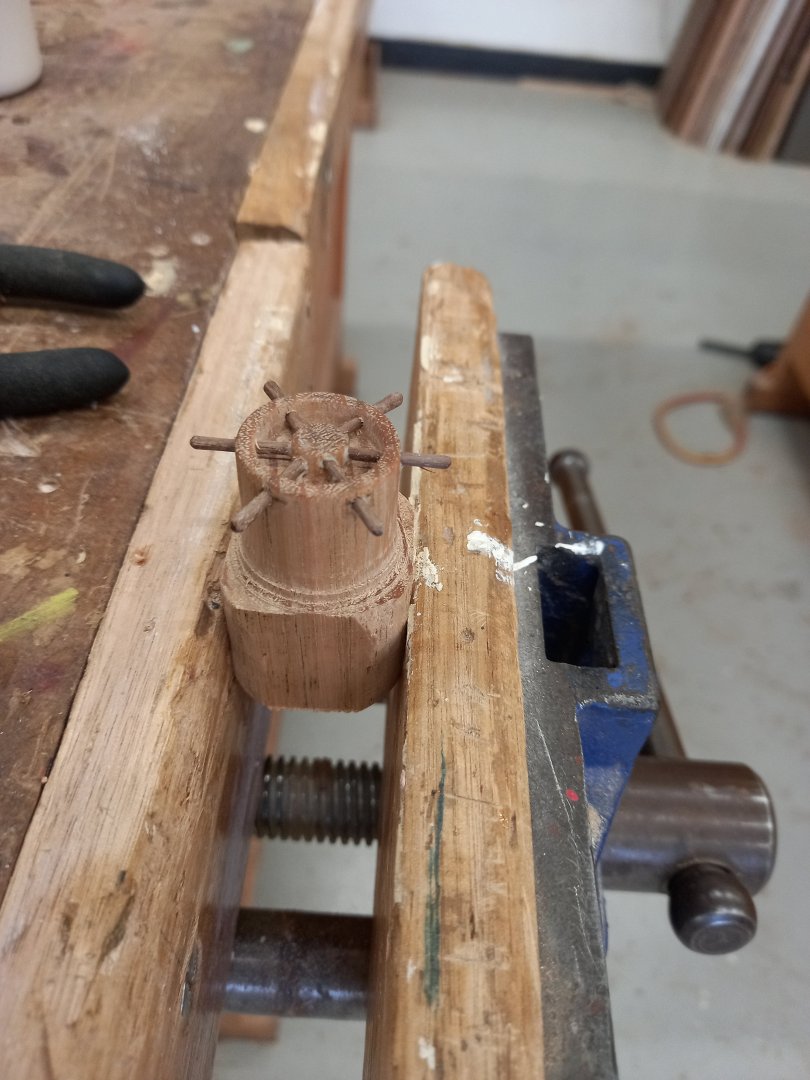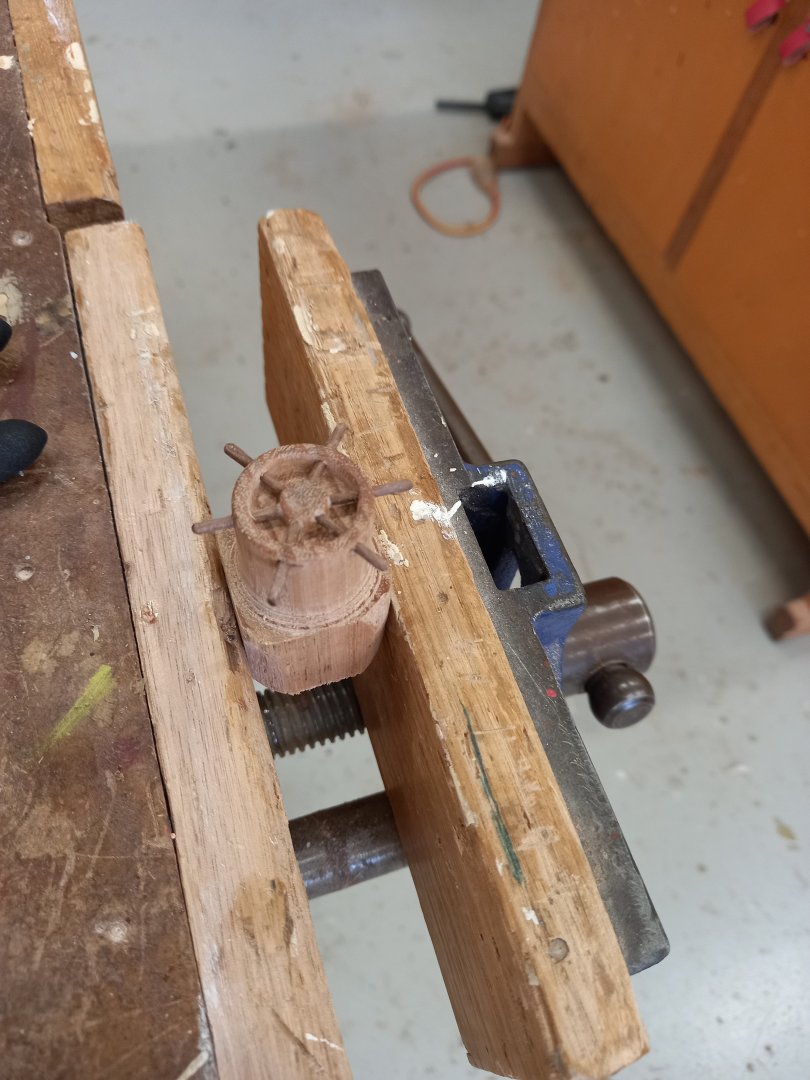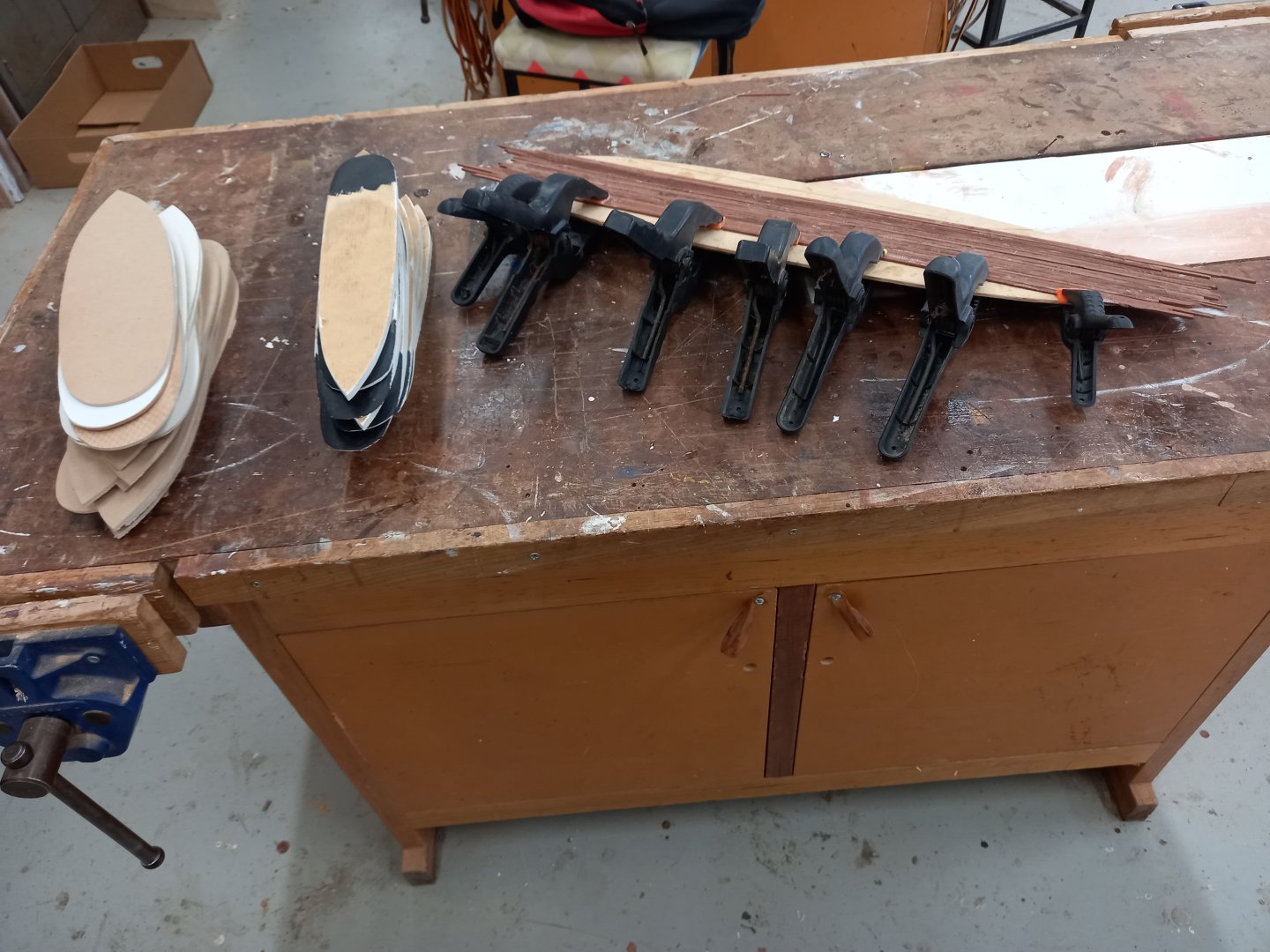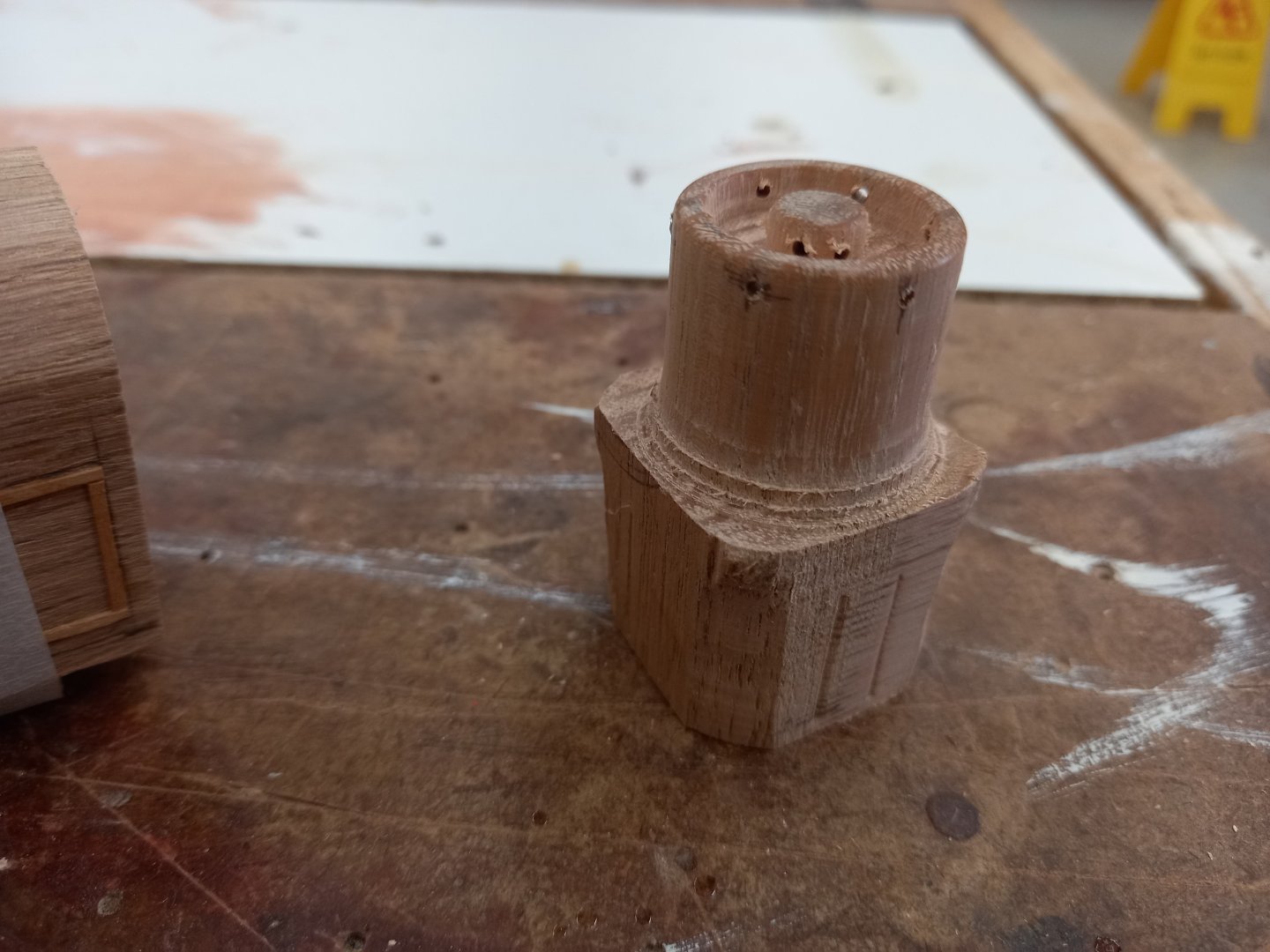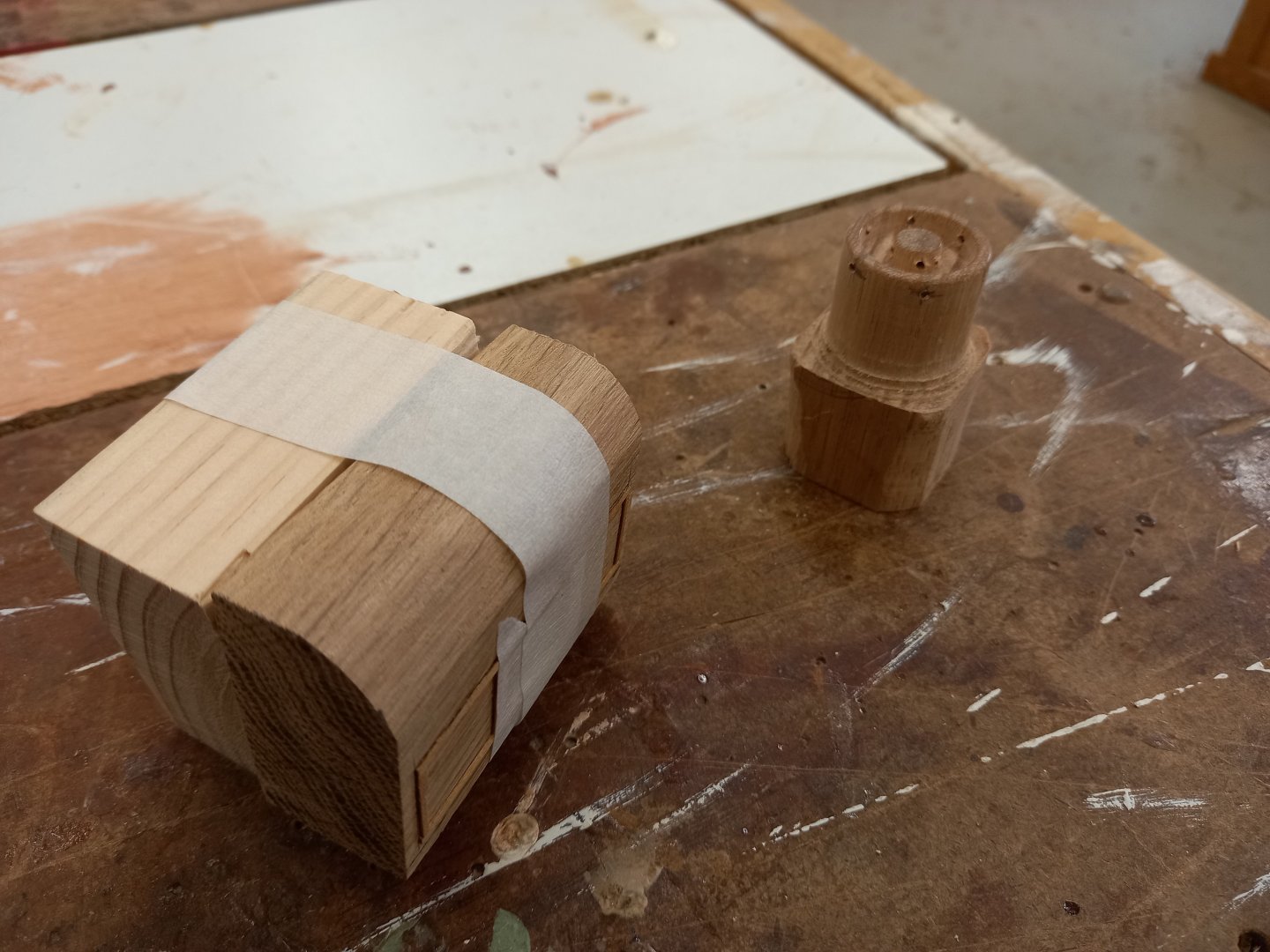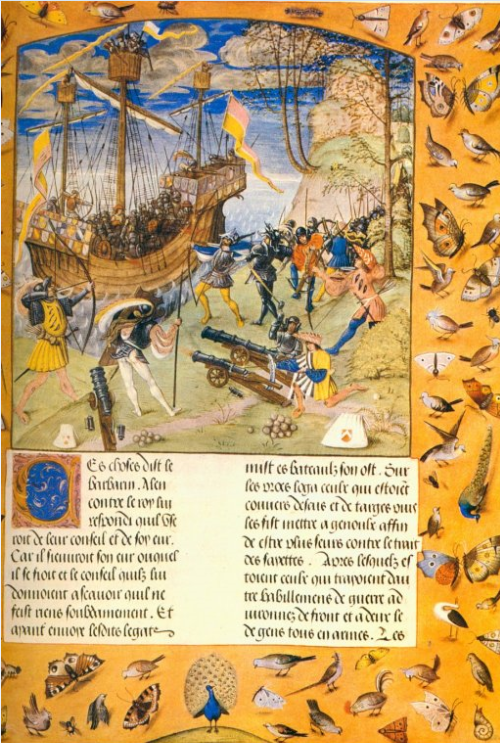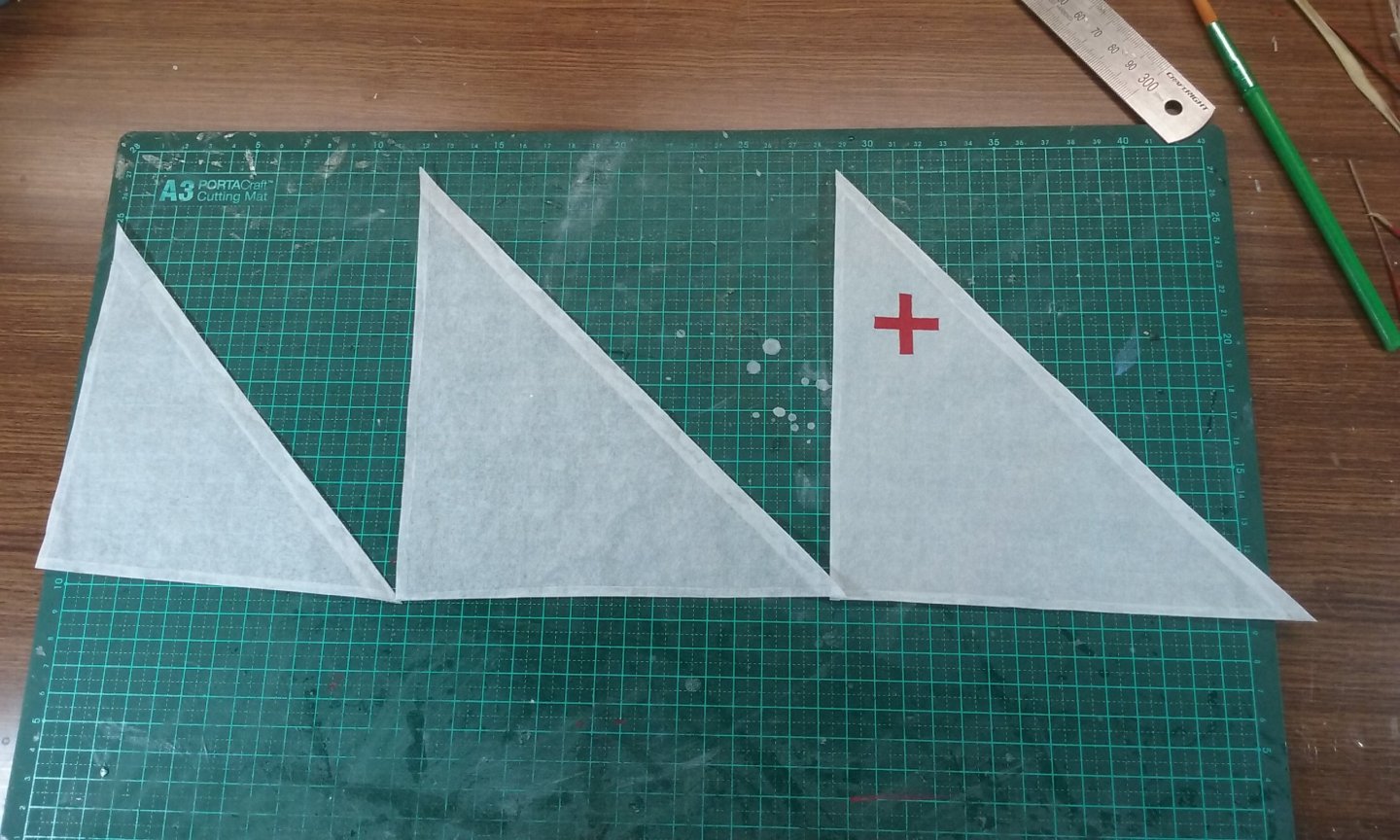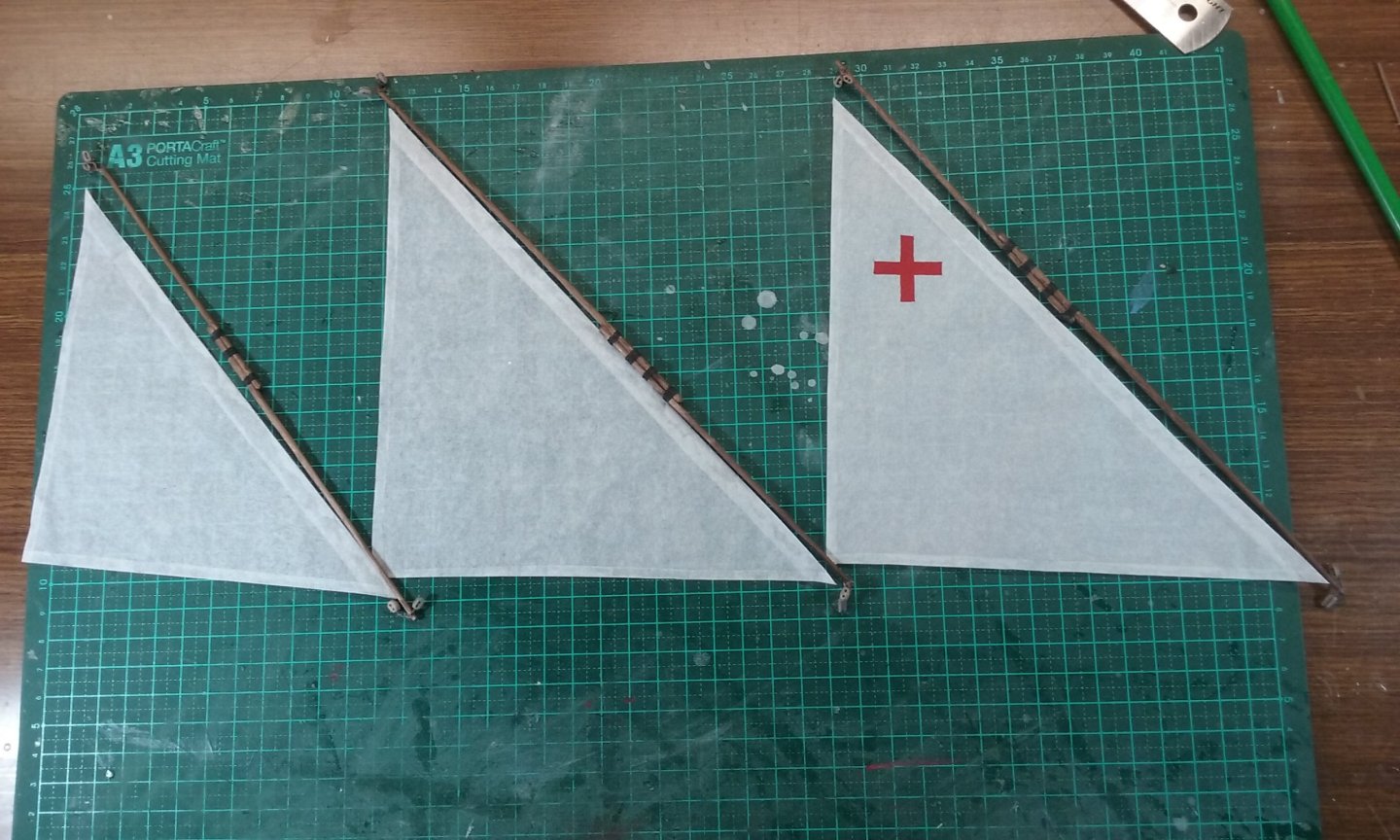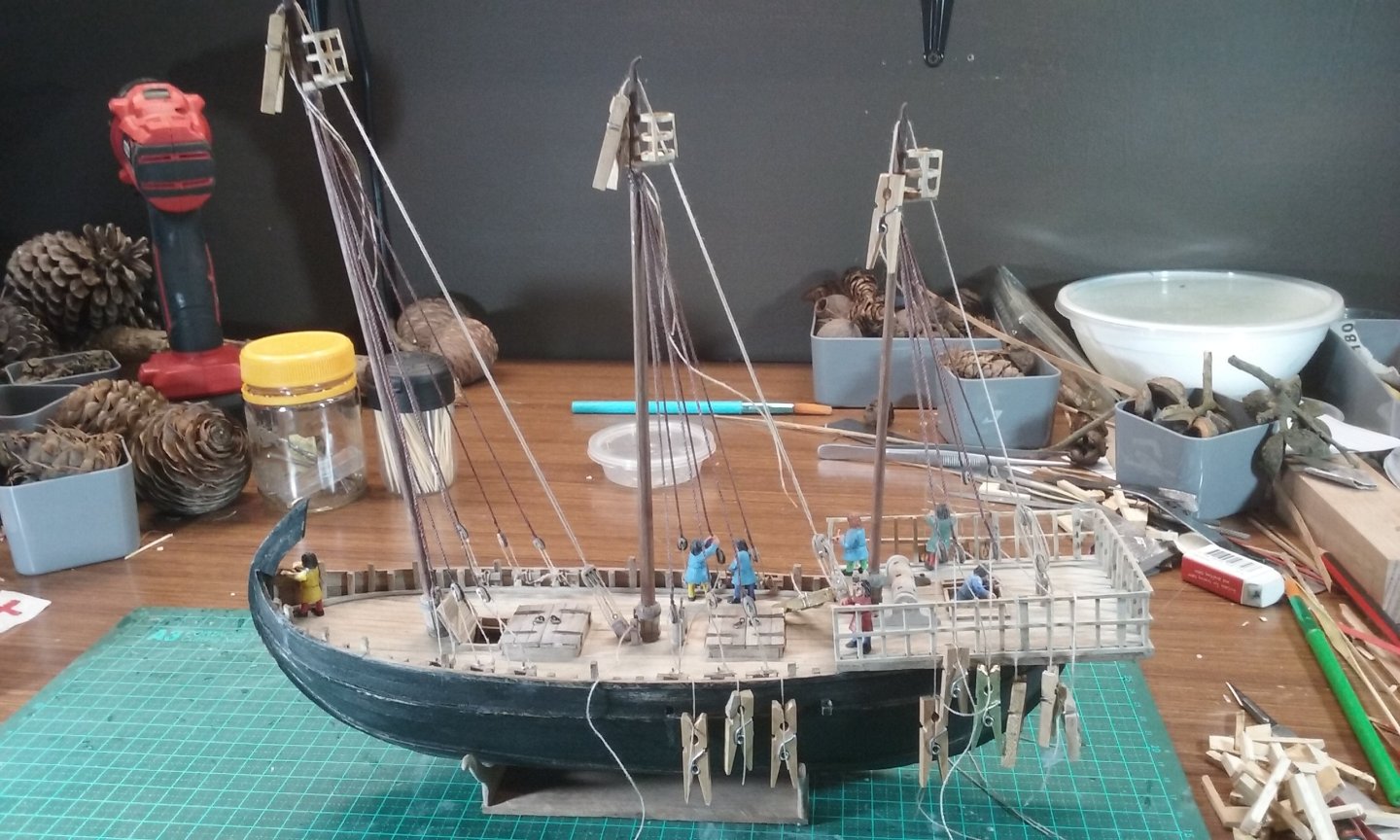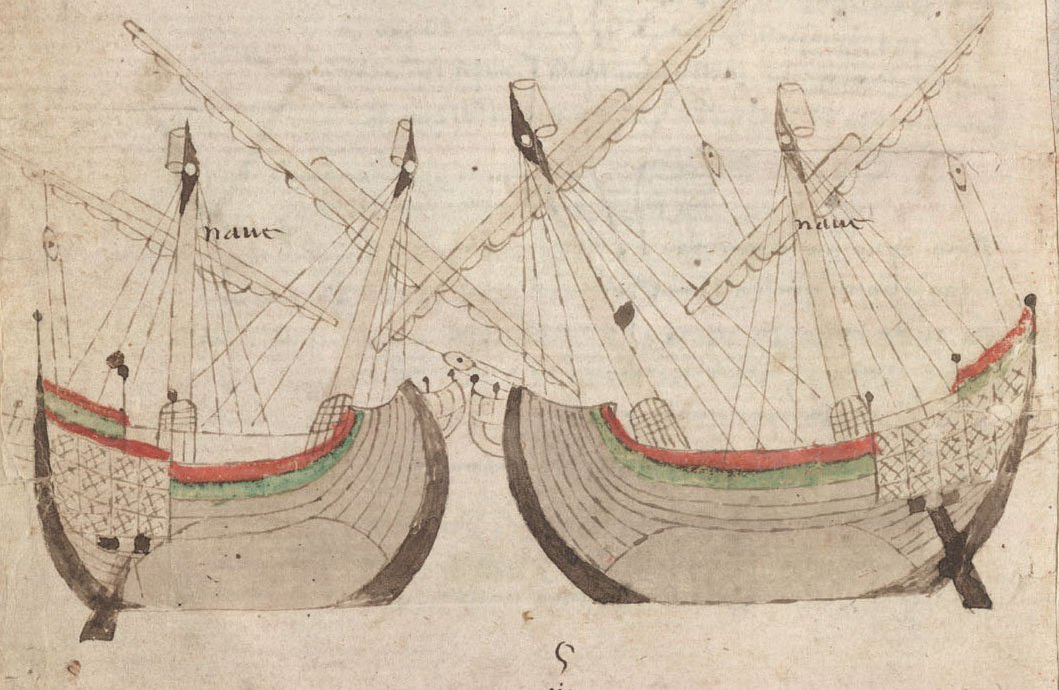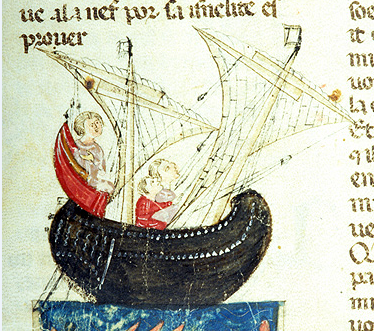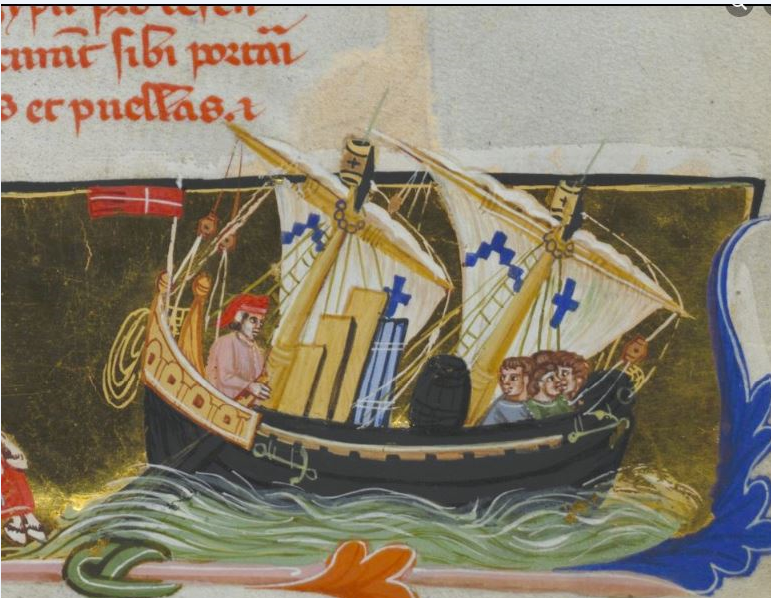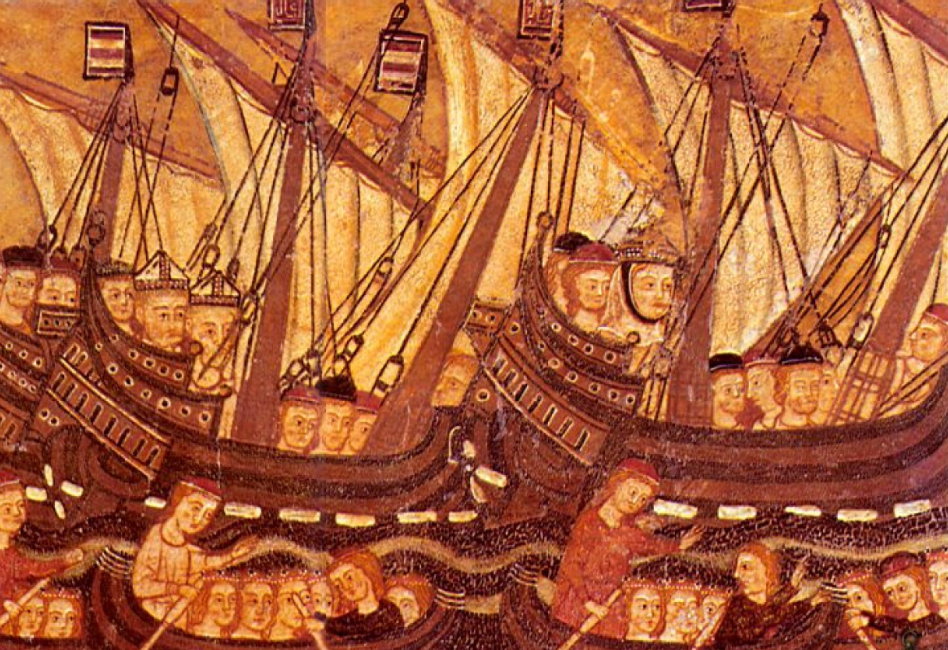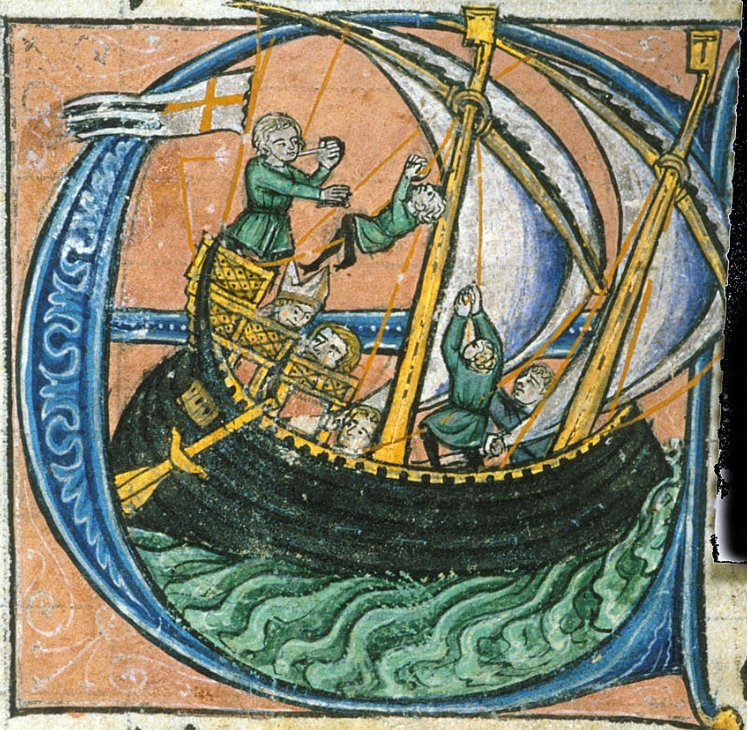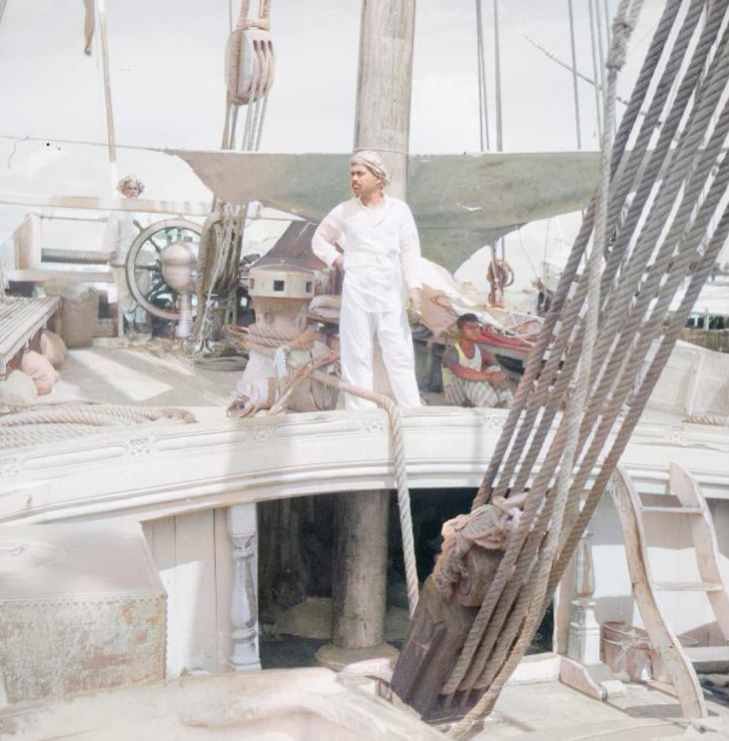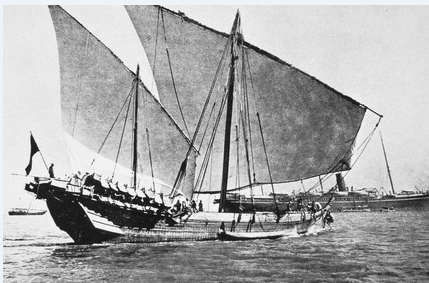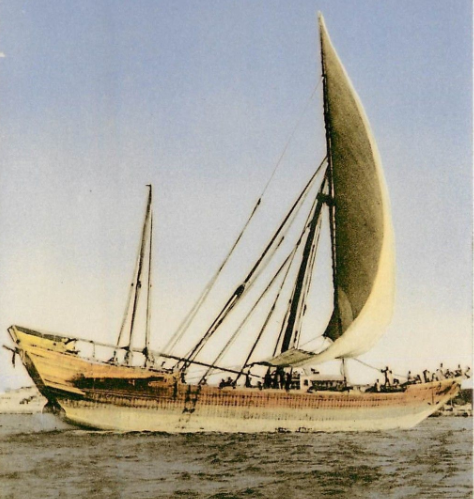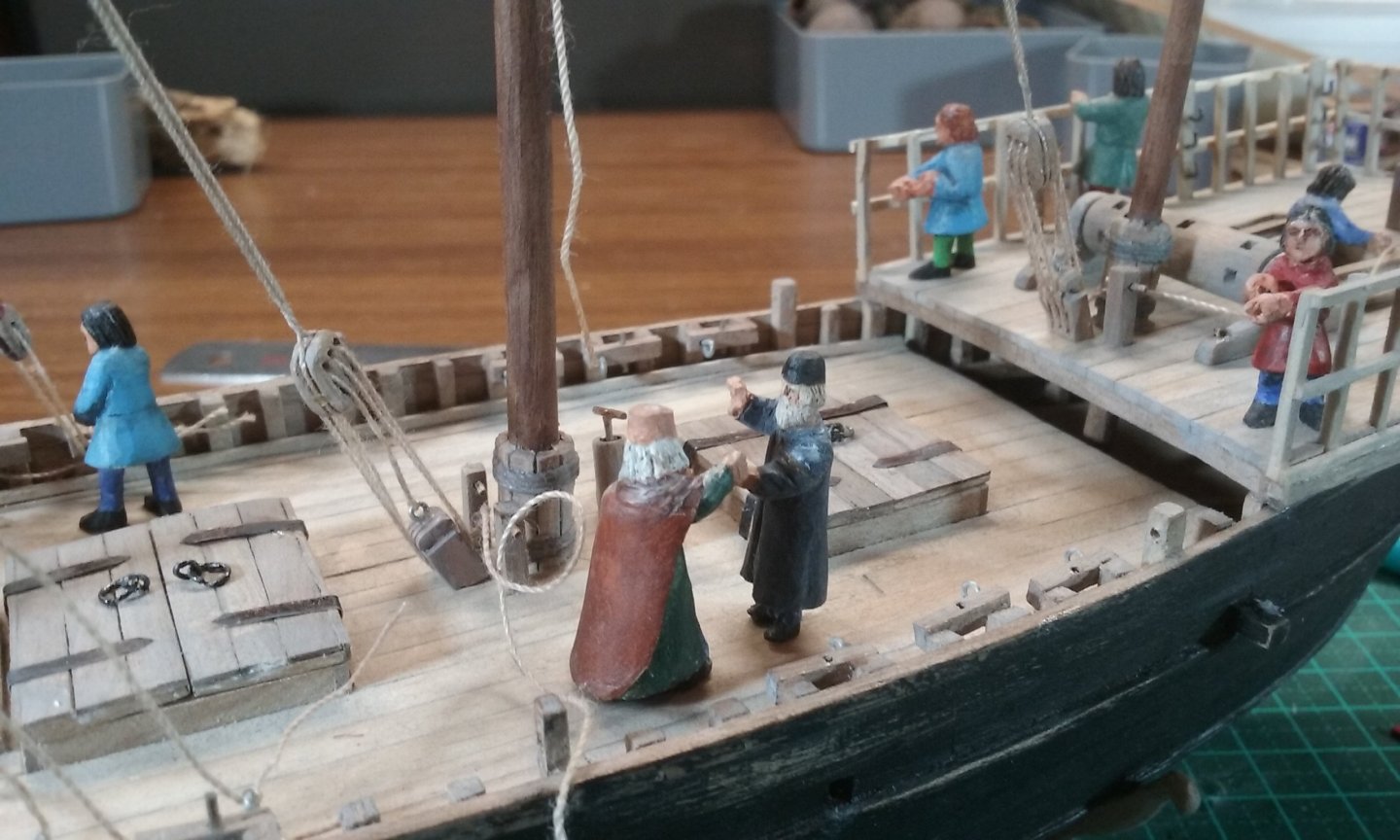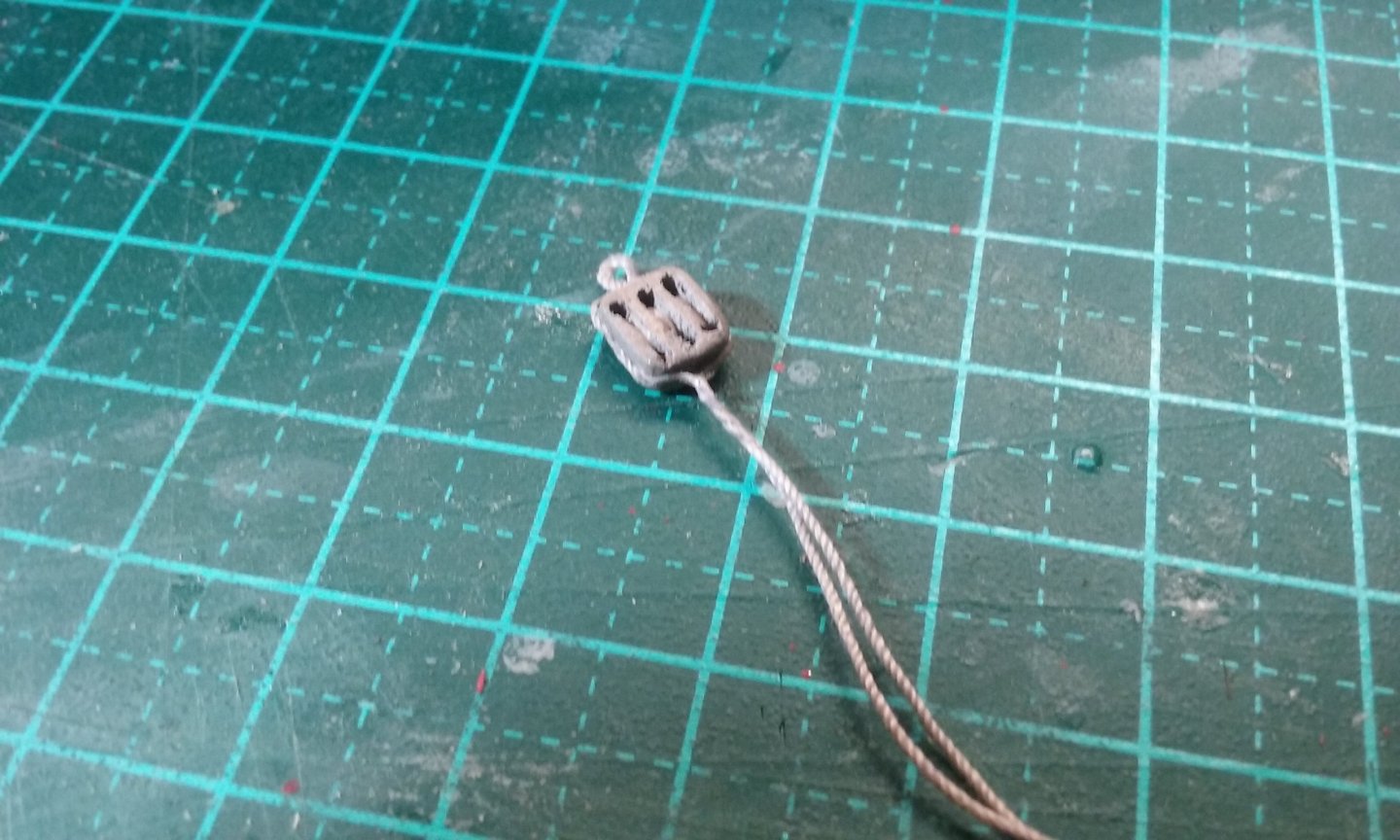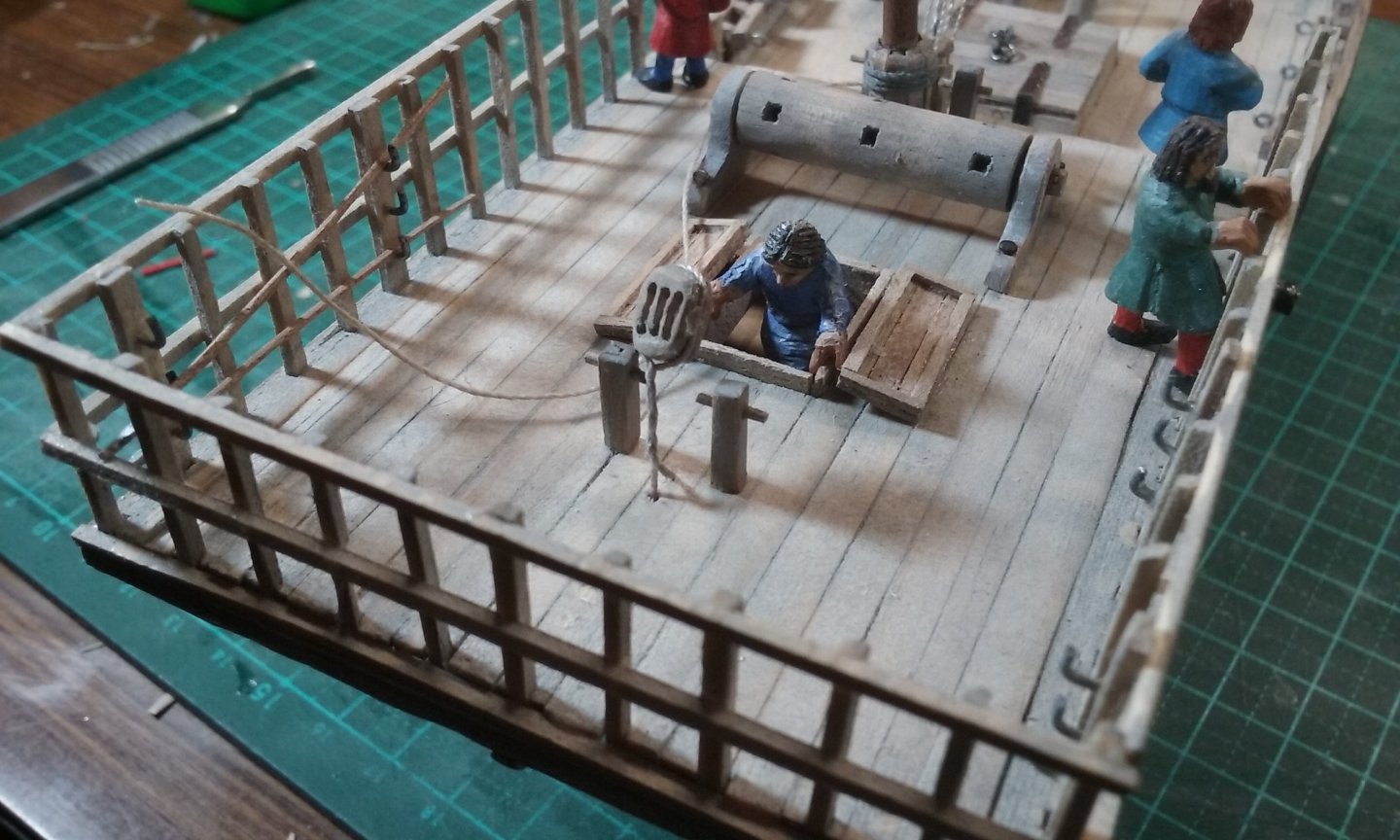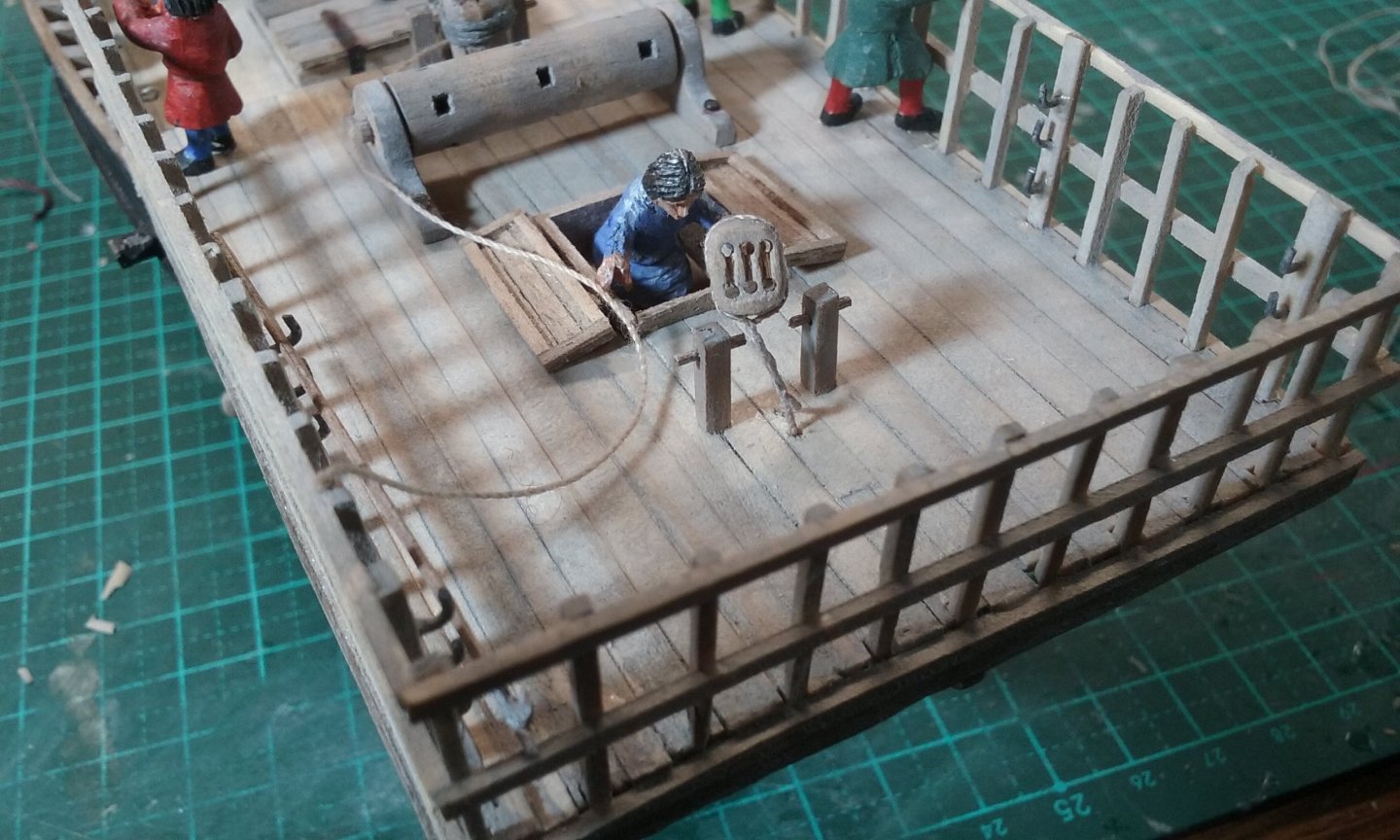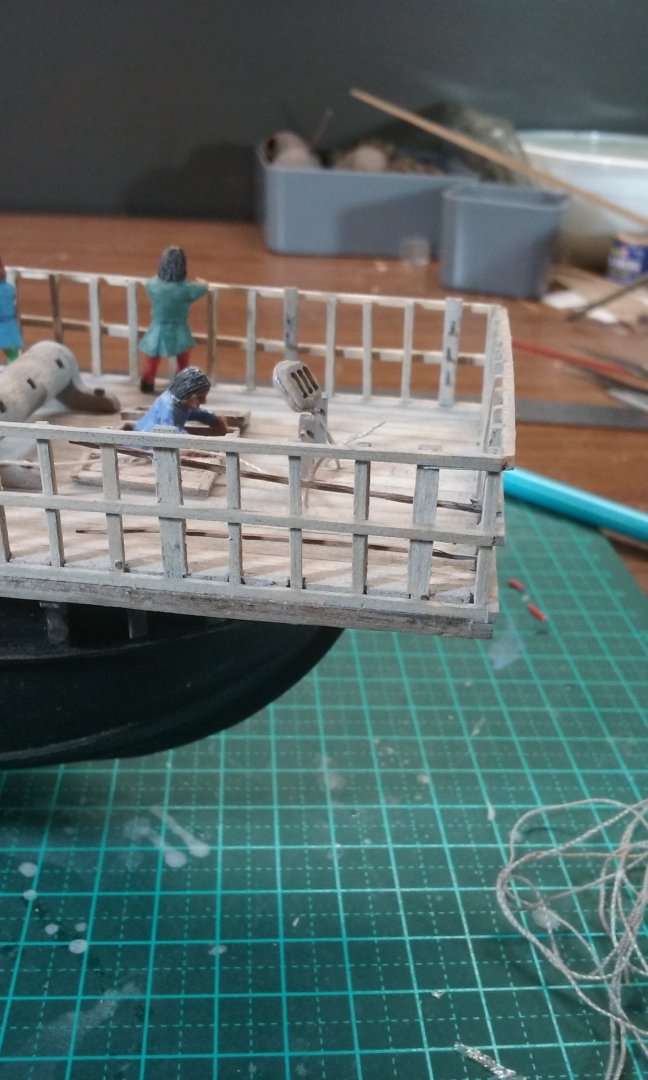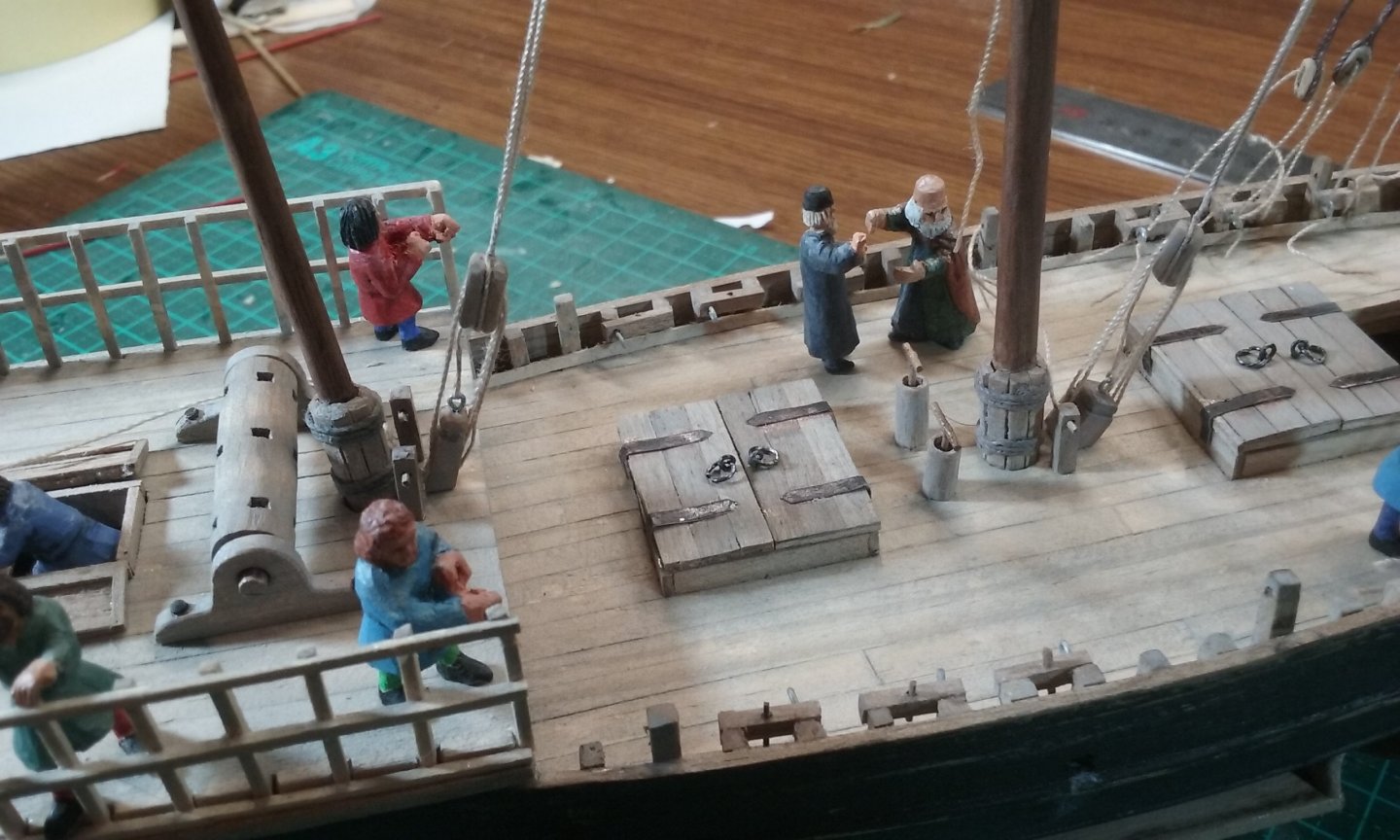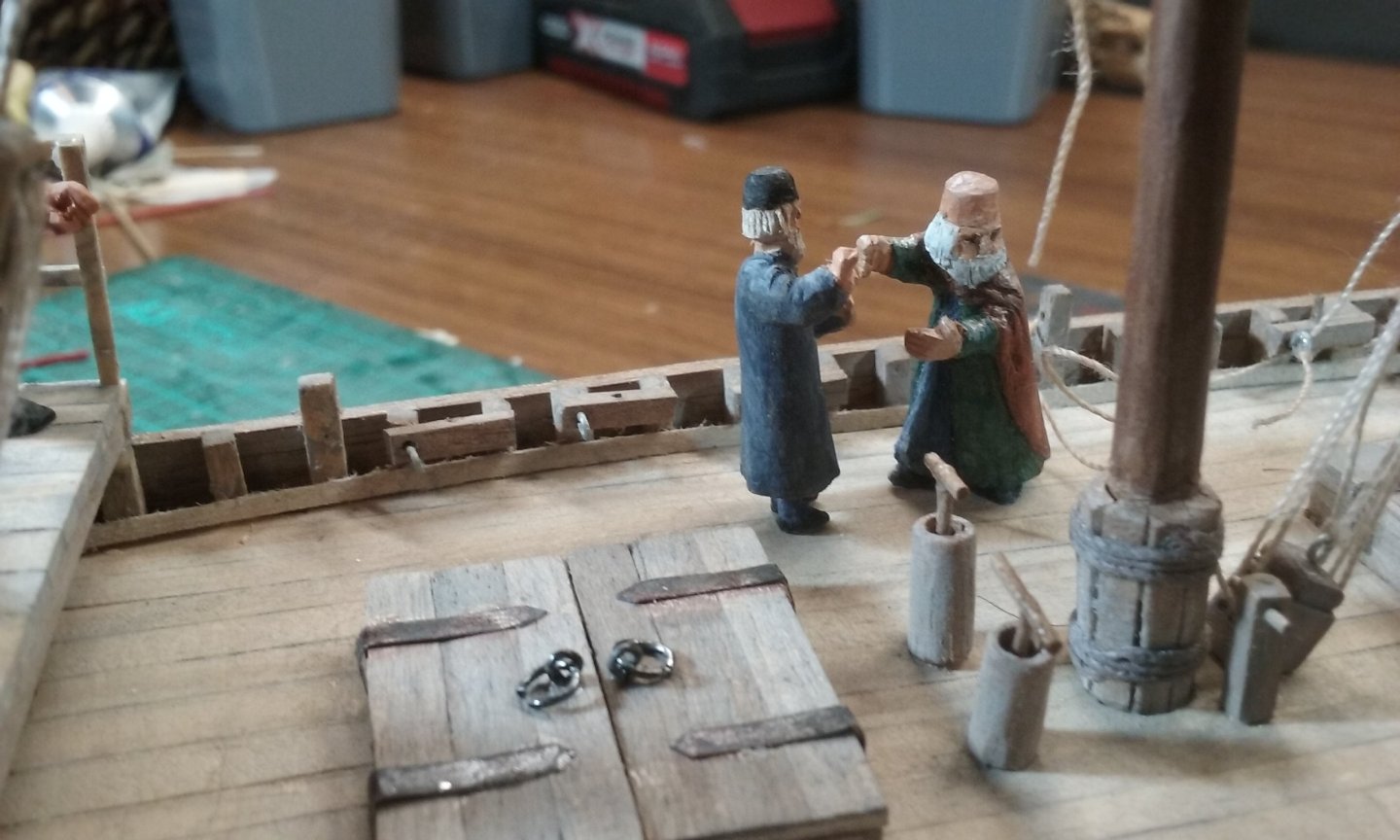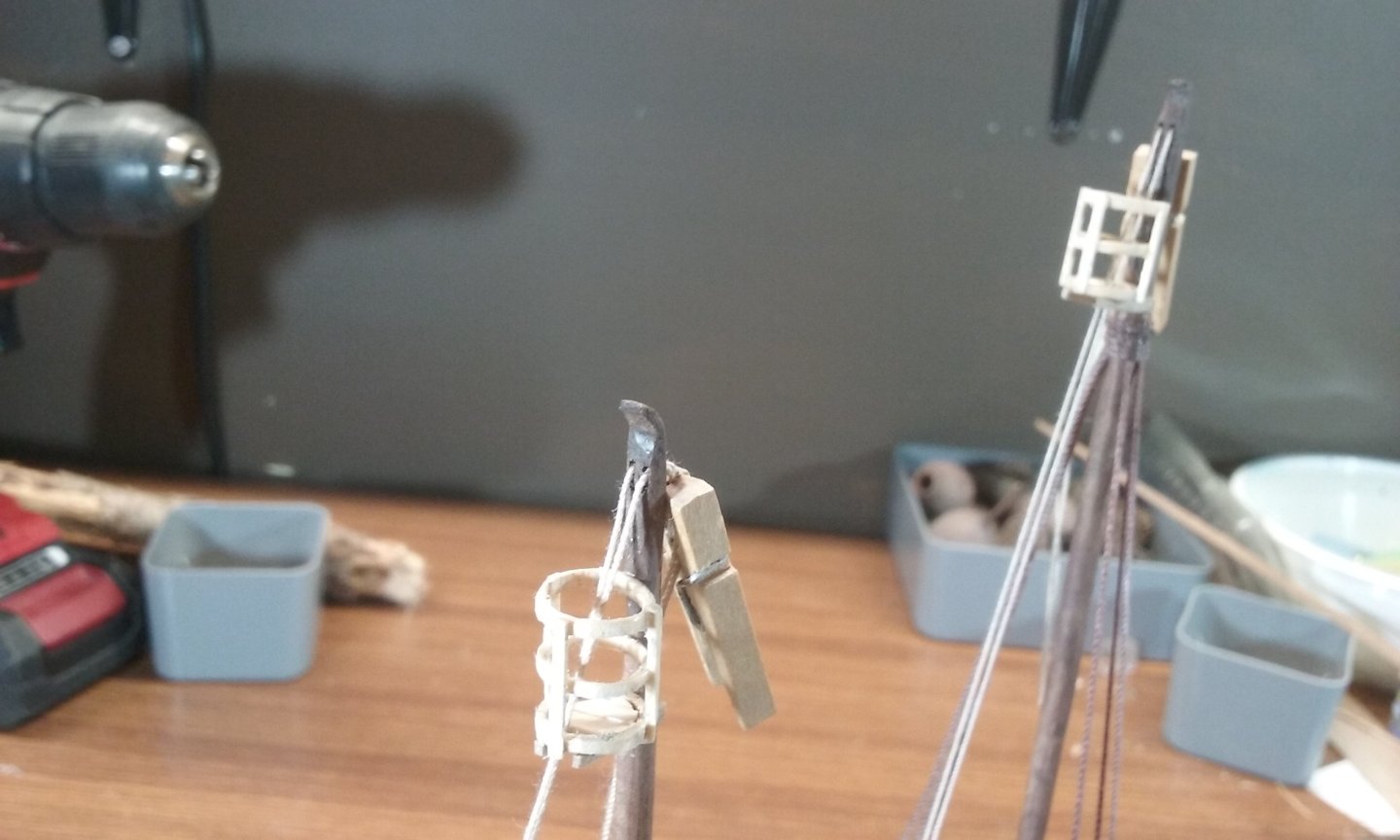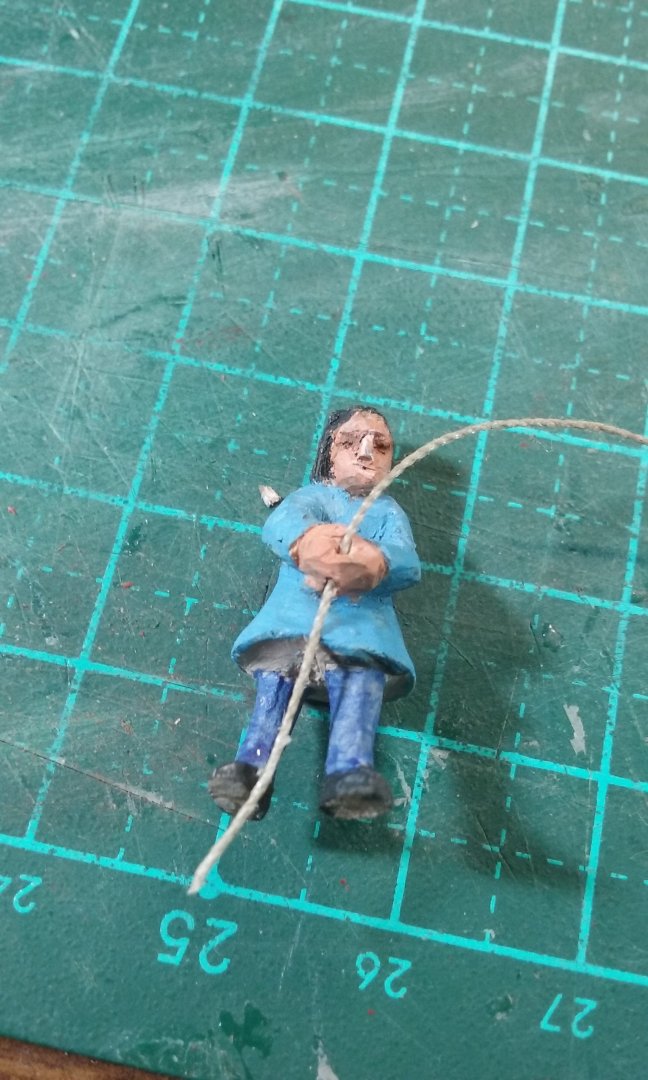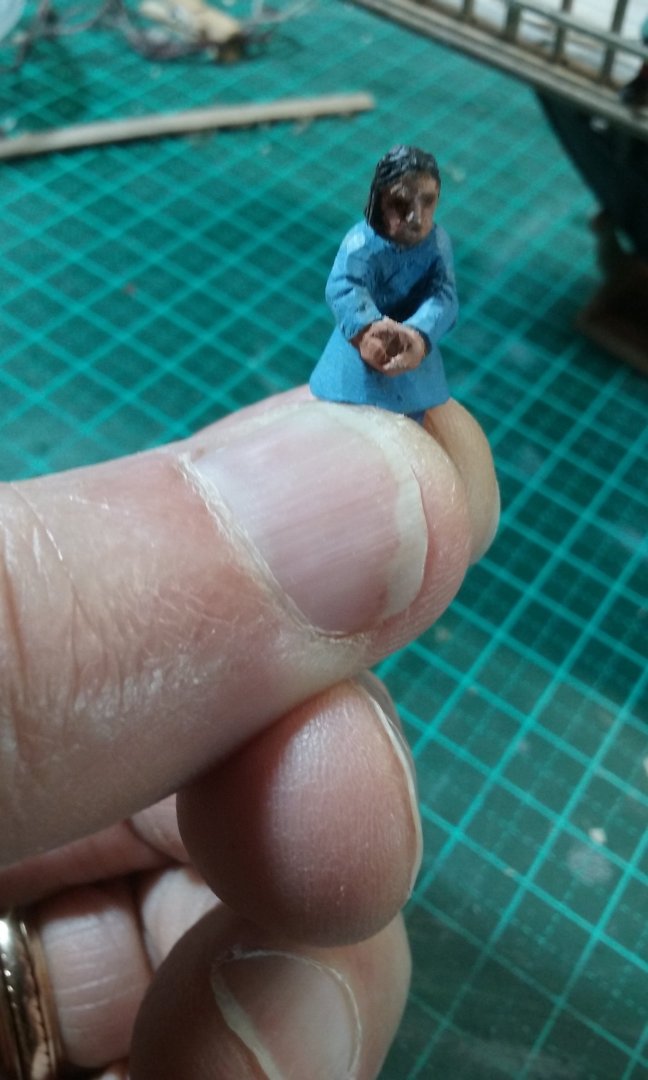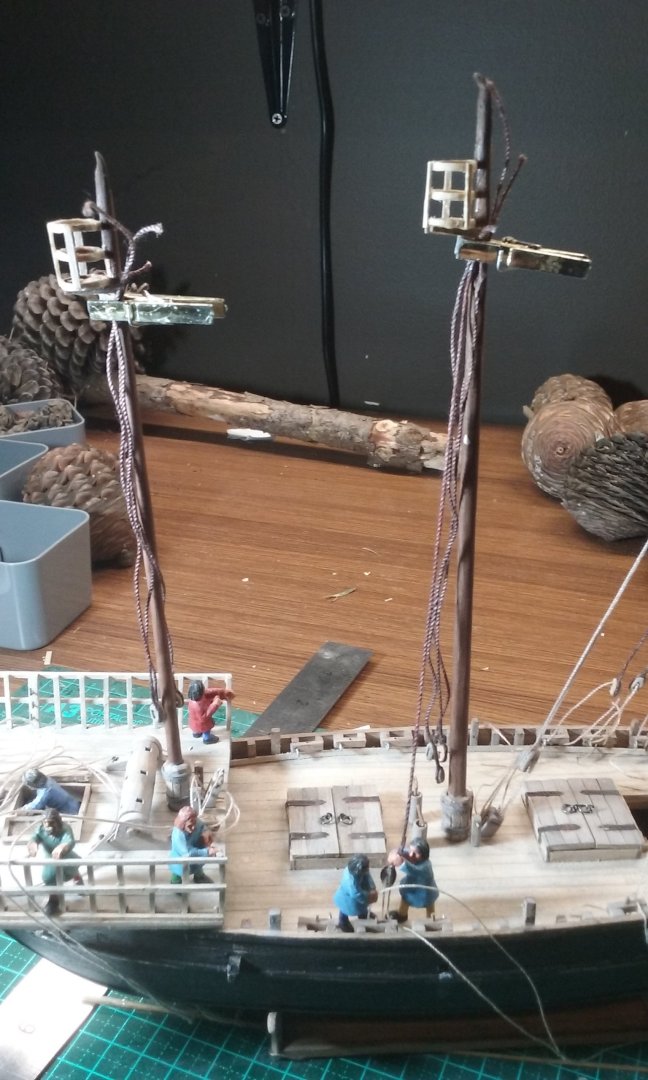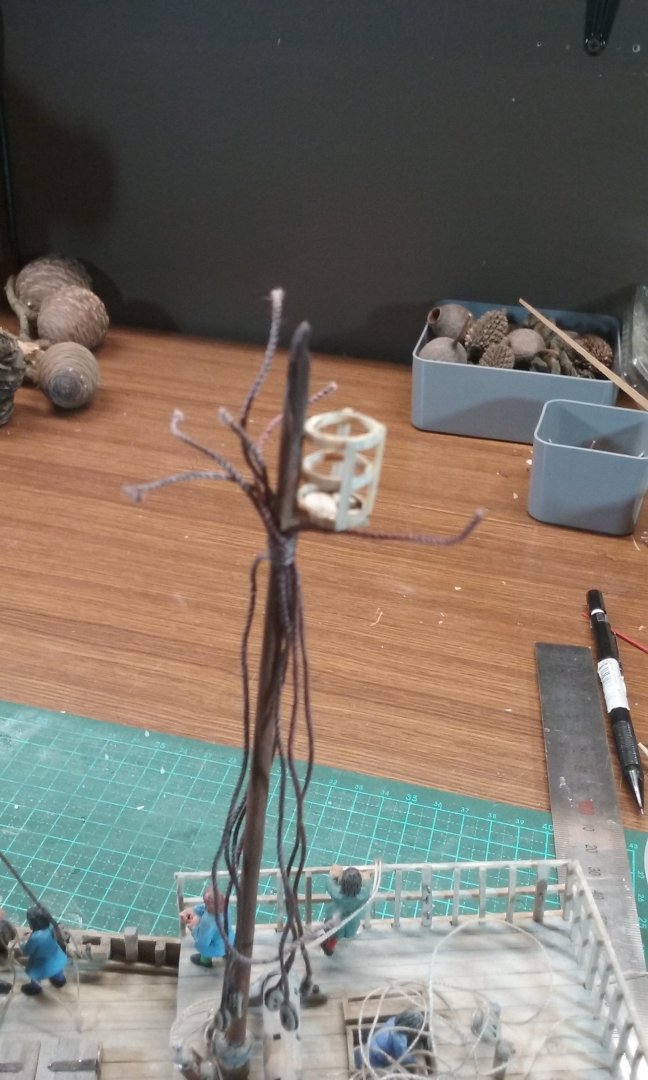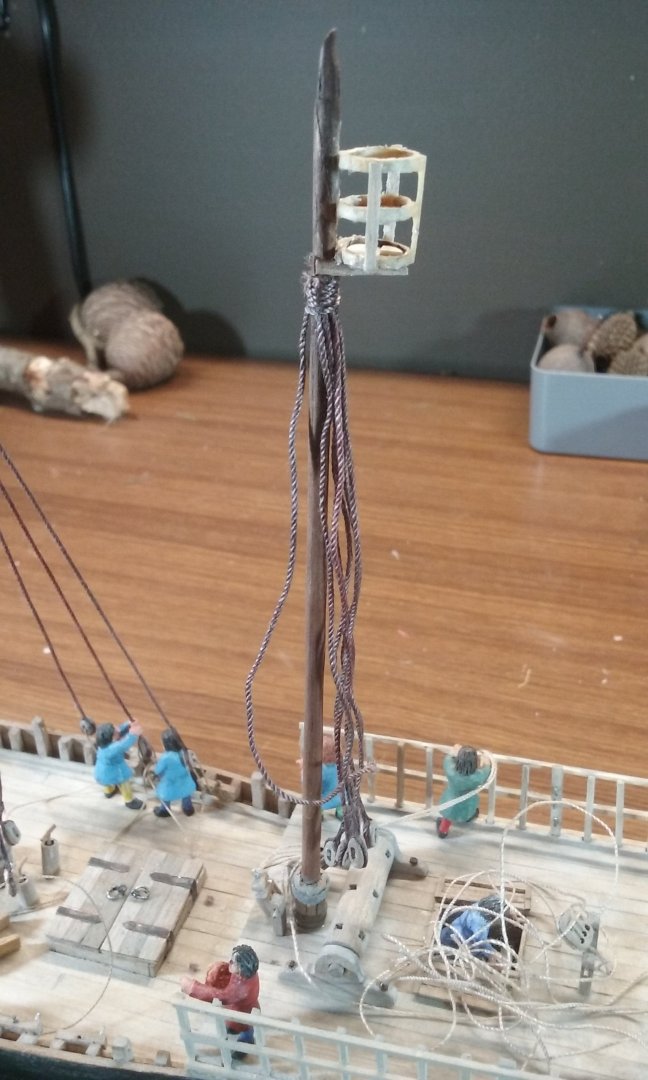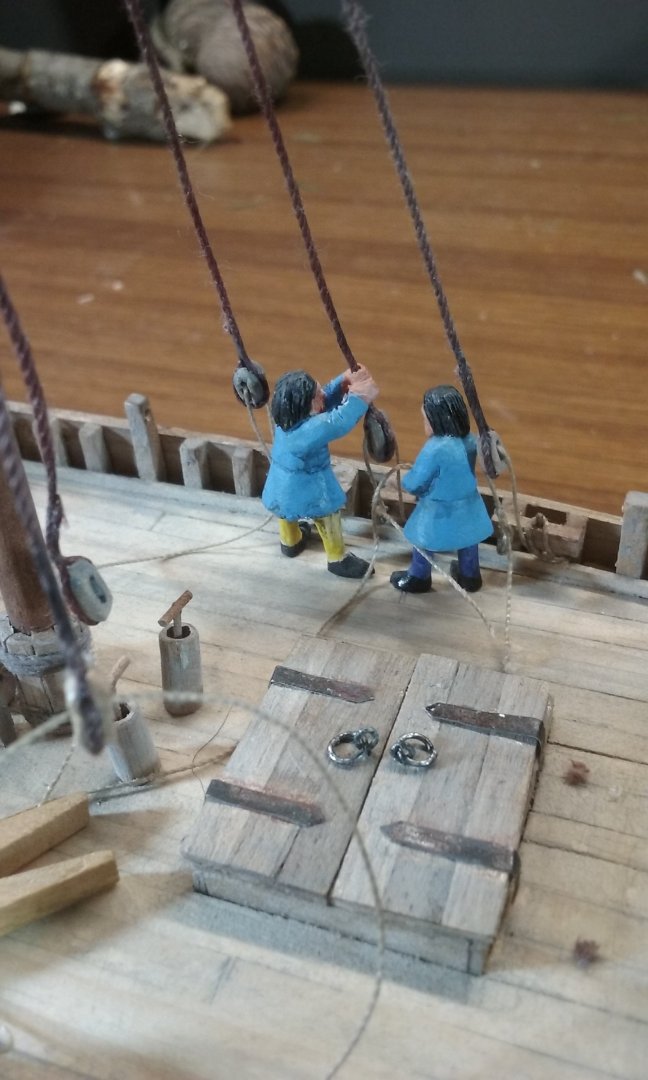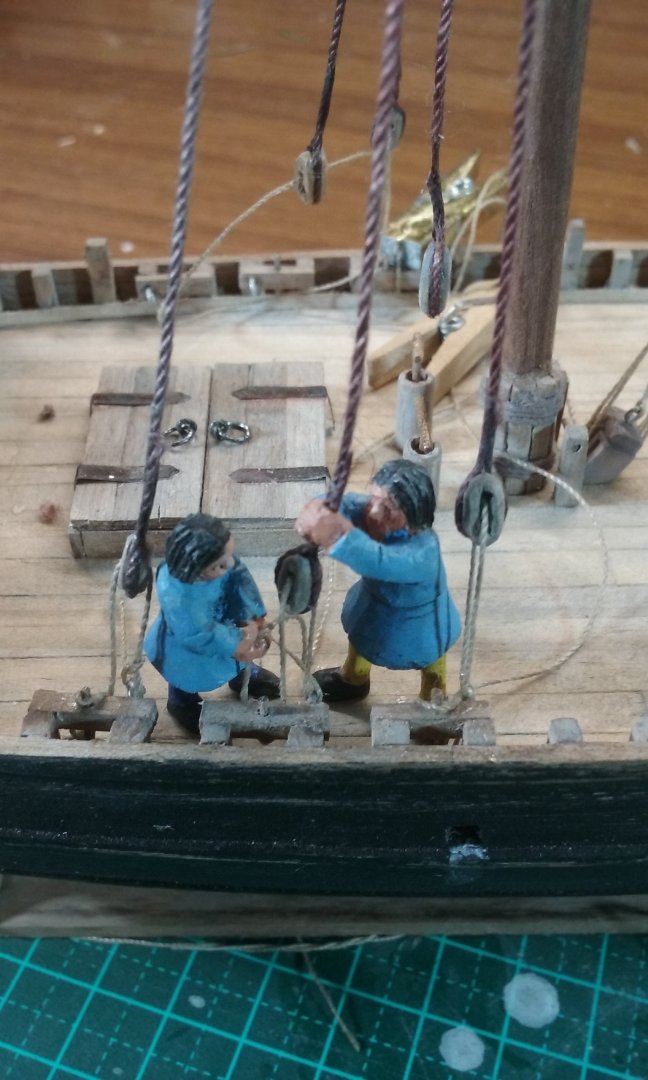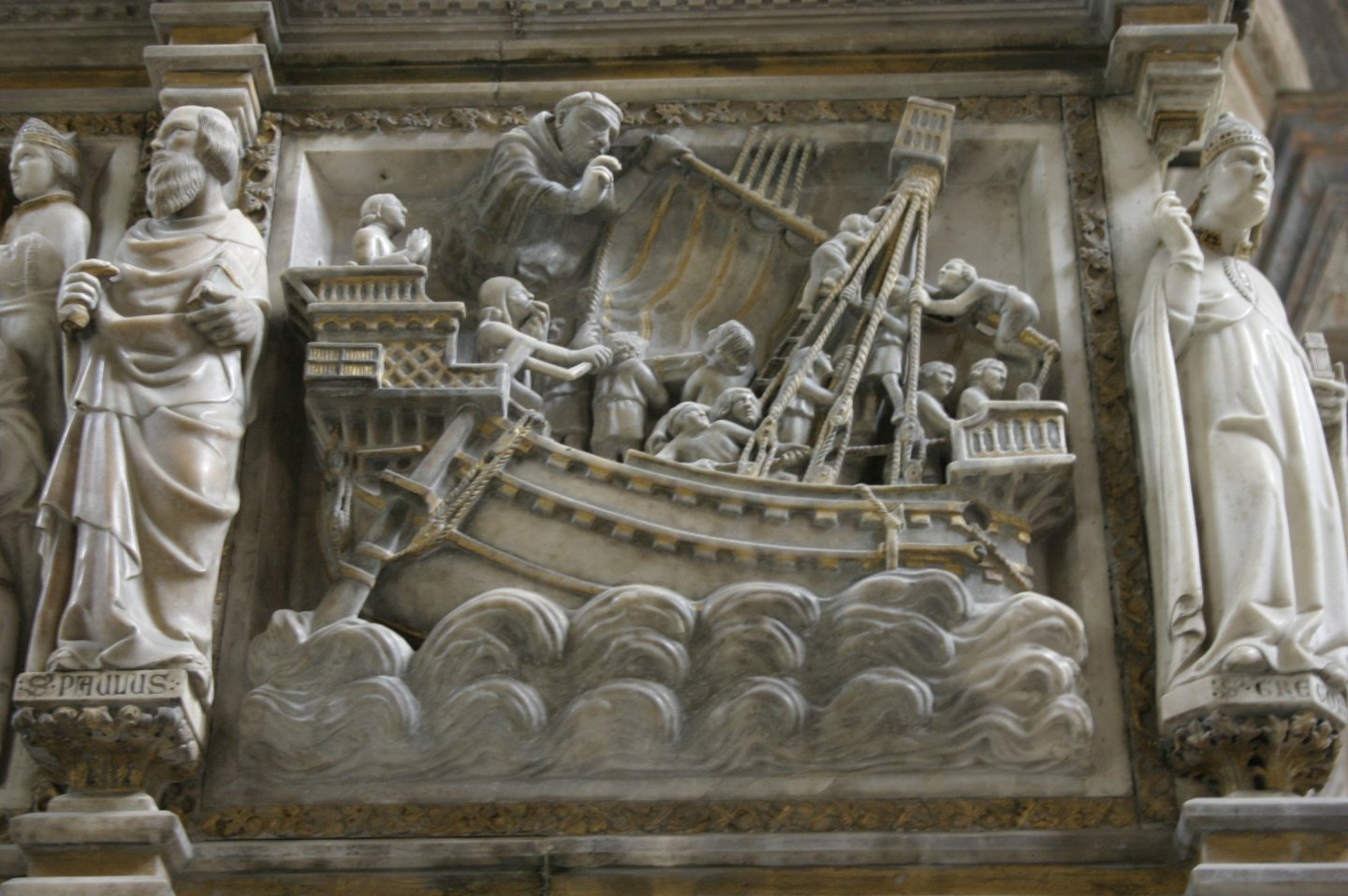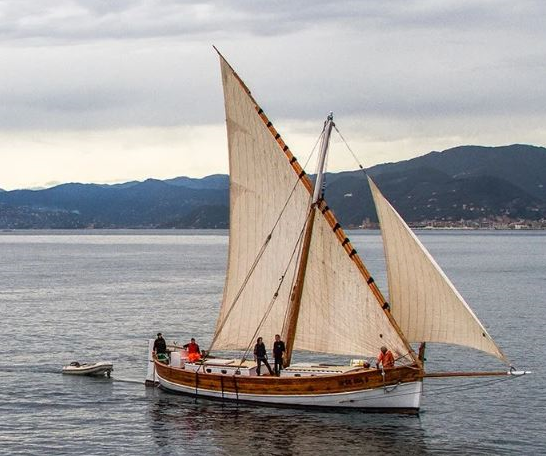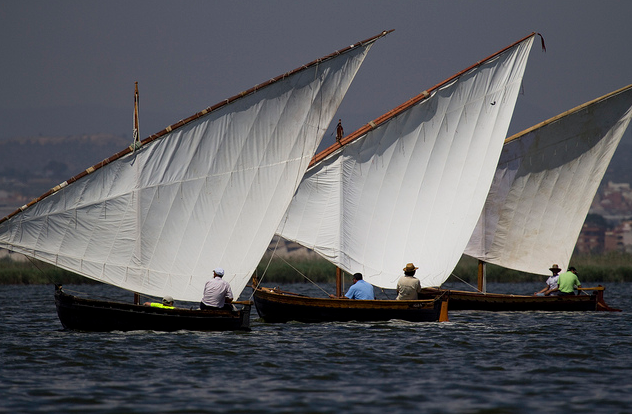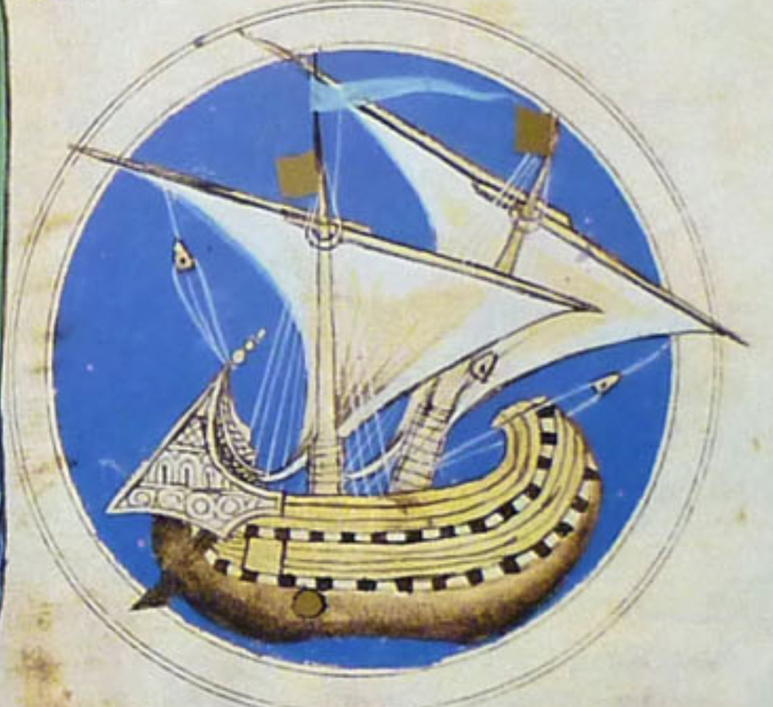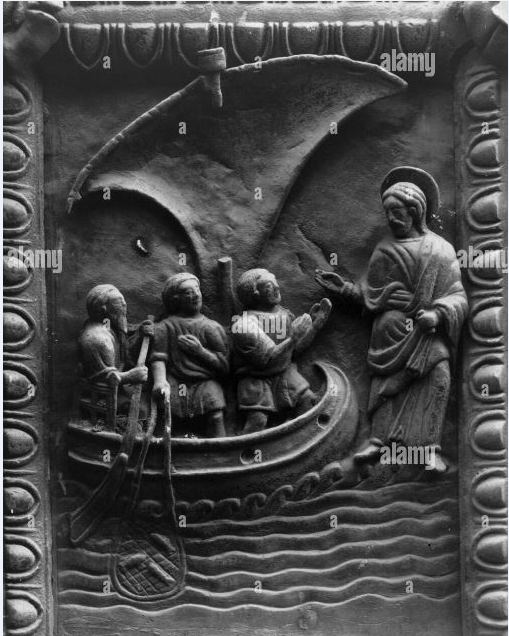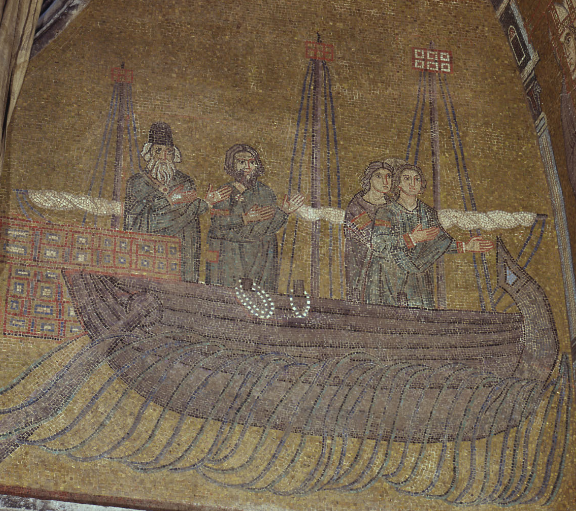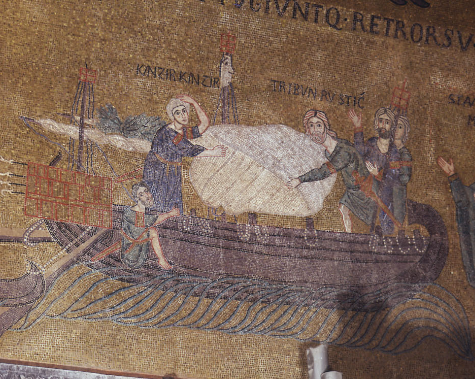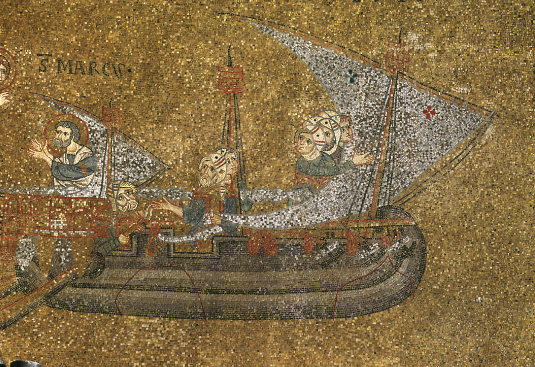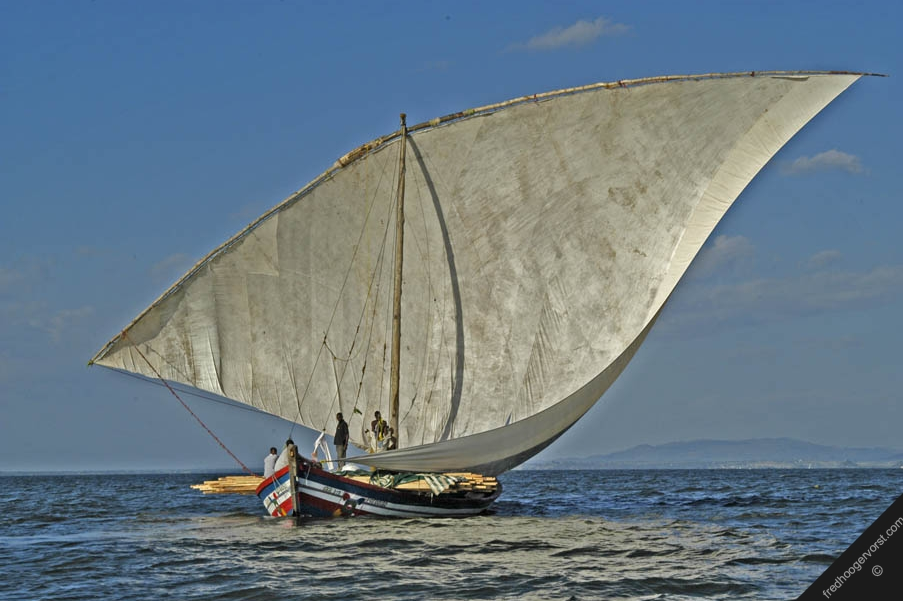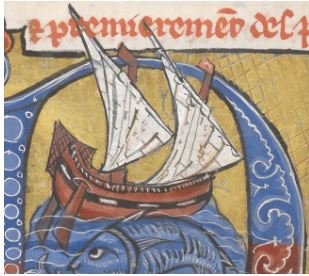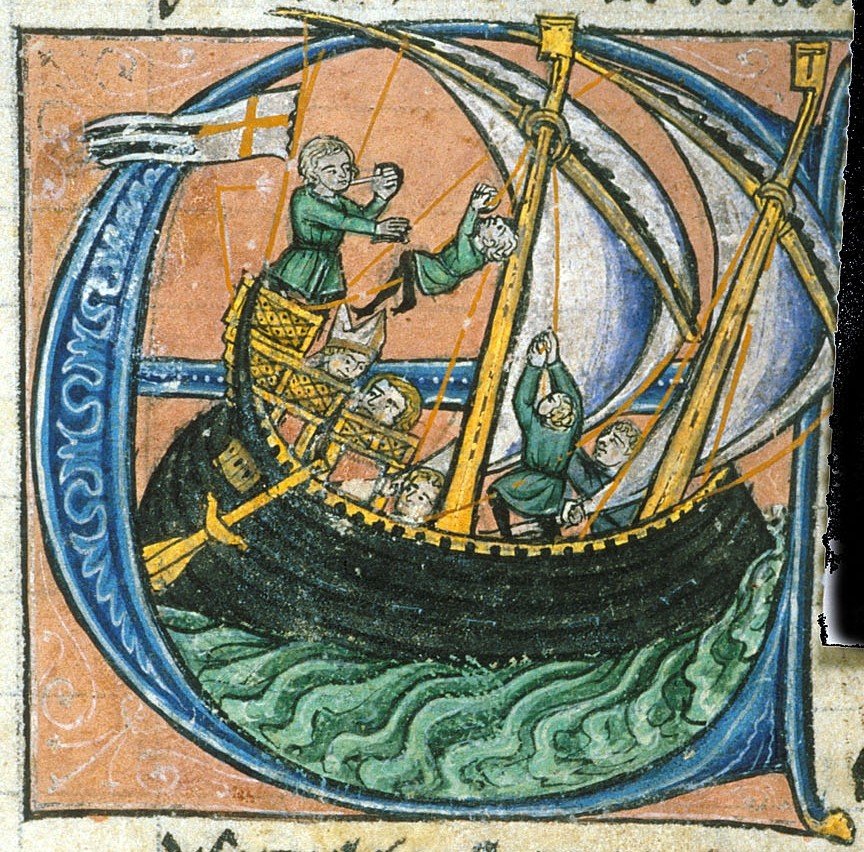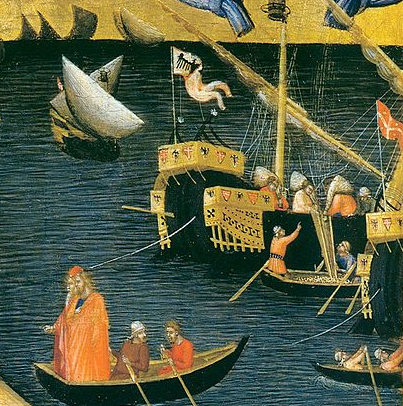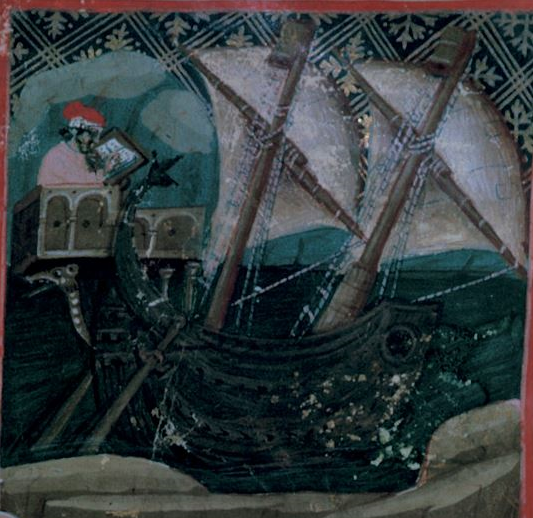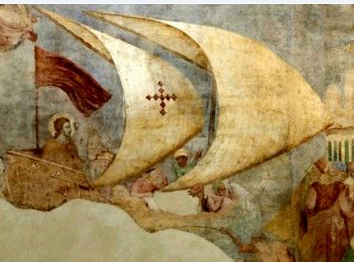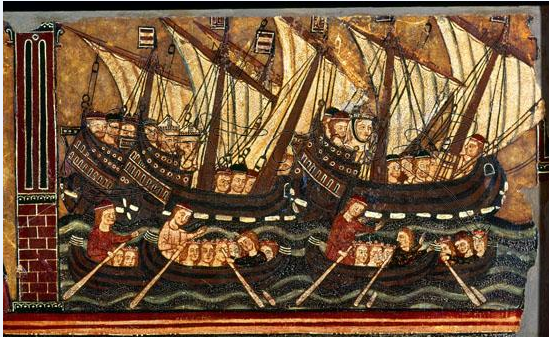-
Posts
7,987 -
Joined
-
Last visited
Content Type
Profiles
Forums
Gallery
Events
Everything posted by Louie da fly
-
And here's the ship's wheel; just waiting for the glue to dry and I can cut it off its base. Should happen on Monday. Wish me luck! Steven
- 110 replies
-
- Paddlewheeler
- Ballarat
-
(and 3 more)
Tagged with:
-
Here are 13 hulls, awnings and 'verandahs' (promenade decks?). And the thing with all the clamps on it is the promenade deck for the big model - I'm gradually adding planks; one or two each day. Plus the deck fittings for the wheel and what I think is storage. And the wheel itself under construction. I cheated with this. I asked a fellow Men's Shedder to turn it on the lathe because I don't have the skills. You can see the little holes in the sides for the handles. Once they're in place I'll slice it off its substructure and we should have a wheel instead of a cylinder. Steven
- 110 replies
-
- Paddlewheeler
- Ballarat
-
(and 3 more)
Tagged with:
-
Glen, 'chuffed' means pleased. You can be mildly chuffed or extremely chuffed. I think they were near the top end of the scale. One asked me if it would be possible to get his yacht model repaired, others were very interested in the idea of selling the models to the public - lots of people come here from Melbourne and have a nice trip in the lake in the paddlewheeler. What nicer than to then buy a model of the boat? Roger, I agree about the cost factor. The wood is donated - we have far more than we know what to do with, and the machinery to cut it to size. I'm hoping I can figure out a jig to make mass production easier. Oh, and 13 is just the start! Steven
- 110 replies
-
- Paddlewheeler
- Ballarat
-
(and 3 more)
Tagged with:
-
Thanks for the likes and comments everybody. I got into preparing multiple 1:50 hulls today - I think I have about 13 made so far. But I only have half a dozen "verandahs" and awnings so far, so I've got some catching up to do. Also working on the sort of roll-top desk thingy (see photo No. 3 in post #18 above) for the big model - it supports the wheel on the full-sized vessel, but I'm only doing the wheel for the big one. I have a cunning plan for how to make it. It remains to be seen whether it will work. Pat, 3D printing would certainly save time and effort, but as I have absolutely no experience or equipment I expect I'll just build up the seats and gates with strips of wood (and they're free!) Steven
- 110 replies
-
- Paddlewheeler
- Ballarat
-
(and 3 more)
Tagged with:
-
I was invited to take the almost-complete 1:50 model along to the meeting of the Golden City Paddle Steamer Museum Society (the group of volunteers who own and run the Golden City) so they could have a look at it. They were all very chuffed with it, thought it was brilliant, loved the idea of selling 1:50 models to visitors as a fundraiser. And wanted to know if the big (1:25) model would be ready to display in time for the "season" (they only run the full-sized one on the lake from October to April due to Australia being upside down and having winter in June.) I wasn't able to give a definite undertaking because of uncertainties in what problems might arise in building the big one, but just between you and me I think it's quite possible. They even have a big glass display case (museum-sized) which they recently acquired and in which they plan to display it. All rather positive. Now I actually have to deliver the goods! Steven
- 110 replies
-
- Paddlewheeler
- Ballarat
-
(and 3 more)
Tagged with:
-
I've put quite a bit of study into guns of this period, and you're certainly on the right track. You might be interested in this gun from the Genoese ship La Lomellina which sank in 1516 (which I believe was probably built in 1503). And this picture which I believe shows the Lomellina's predecessor, which sank in 1503, as it is flying the flag of the Lomellini family, and which has some interesting cannons. Steven
-
I believe this must be the original inspiration for C.S. Forester's book The African Queen, on which the movie is based, except that the director, John Huston, changed the ending. In the book the African Queen doesn't sink the Königin Louise - instead she is lost on the storm and Rose and Charlie's quest fails. Then two fast motor launches with quick-firing guns, transported overland to the lake, out-manoeuvre and sink the German ship. To be honest, I prefer the movie ending. As well as the superb work by Bogie and Kate, who did a beautiful job of portraying two ordinary people (Rose has become resigned to her role as the support for her mediocre brother, and Charlie is a silly weak little man) who fall in love and together achieve something magnificent. Steven
-
Thanks Roger. That's my opinion entirely. A lot of this is educated guesswork based on (extremely!) inadequate source material. Of course we can't be sure it's all correct, but a lot of the fun is in the investigation of source material and speculation as to how it could be done, given the pictorial evidence (often affected by artistic licence), the archaeological evidence (often frustratingly incomplete) and the practicalities of sailing a wooden vessel. And if later evidence proves one of the guesses wrong, one still has the satisfaction of having done the best one could with the information that was available at the time. So, on to current progress. Shrouds and halyards in place, but only the foremast shrouds have been finalised. I really do need to clear my workdesk before I take photos! I made new silkspan sails - I wasn't happy with the first iteration. This time I made them oversize and folded the edges over instead of gluing strips of silkspan to the edges. The cross was painted on with Tamiya acrylic paint. I needed two coats for the "face" side and one for the other side. Considerably happier with the second version. And I've added the blocks to the yards - for the tacks at the lower ends and the vangs at the upper. Druxey, if I might pick your brains - how did you attach the bolt ropes to your silkspan sails (they look particularly good)? And the robands? Steven
- 508 replies
-
You've done a beautiful job. Congratulations on completing - a lot of work, but well worth it. Steven
-
Oops. I'd meant to reply to this earlier, ut it somehow got missed. Very glad to be of help in providing a possible 'backdrop' for your knarr. I'll be interested to see what kind of setting you do end up giving it. I've been thinking seriously about dioramas myself recently (ever since I saw the endless lines of near-identical tanks and aircraft at the Ballarat Modelling Exhibition - interesting for enthusiasts but boring for the general public). I think a setting adds immensely to a model. Looking forward to progress on this one. Steven
-
Looking forward to progress on this one. Do we get more of the back-story about the green drakkar? Steven
-
Thanks, Eric. I'm afraid I'm a bit of a show pony in that regard. I enjoy trying for a bit of extra interest in my builds to spark the attention of those in the know. Steven
- 508 replies
-
Why thank you, Mark. Unfortunately, they are going to be on the weather side, so I think Doreltomin's point stands. However, perhaps a flick of the rudder(s) could take the load off for a short time even if they were weather shrouds. [And of course if they were just completing a tack and hadn't yet got under way, these guys tightening the last weather shroud could well be believable]. Tartane, yes, I'm still going to be using lateen sails. I've looked carefully at your arguments and they aren't convincing enough to make me change. I realise that you have the best intentions in making your suggestions, but I have done plenty of research of my own and I'm satisfied that I'm making the right decisions. What may have been the practice for a chebec in the 18th/19th century is by no means necessarily what was done in the 12th century, and I believe I have ample evidence to back me up. Theoretical reconstructions will always be a matter of interpretation of the available evidence, and our interpretations are different. I think the best policy is for us to agree to disagree. I'm not really willing to engage in any further discussion on these points, as I find it's distracting me from the build. Steven
- 508 replies
-
Doreltomin, you're probably right. But I'm not going to carve another figure - the mistake will just have to remain for eagle-eyed people like you to spot and comment on Tartane, thank you for your input, but despite your belief that the halyards in this configuration would foul the sails, that nonetheless seems to be the way they did it. Note the position of the halyards on these two 2-masted ships - they lead to the black triangle at the top of each mast and around the white dot (the sheave) and back down again. Zibaldone da Canale early 14th century And the same applies with these ones Bestiary Morgan Library ms4 59 fol 18r North Italy c. 1290 1232 - 1261 Bohemund: William of Tyre's Histoire d'Outremer, BL Yates Thompson 12 f.58v And these 1332 Italy, KBR ms. 9404-05 - Liber secretorum Fidelium Crucis St Ursula, Church de San Francisco de Palma de Mallorca 1st quarter 14th century And as confirmation that this is not just artistic invention, multi-masted lateeners and setee-rigged vessels in the 20th century continued to do so: I am quite prepared to believe your contention that chebecs did it differently, but there is sufficient evidence that this was the way it was done in mediaeval times, and has continued to be done this way in many vessels for centuries in between. Steven
- 508 replies
-
After a lively and instructive debate on rigging, back to build progress, . I've now had the opportunity to add some more of my carved figures, plus the knights are now in place and rigged for the fore and middle masts. I have yet to finalise the halyards, but the tackle at the lower end is sorted. For the mizzen mast, there is not enough structure below decks to hold a knight, so I've made a block to be fixed to the deck beams instead. Halyards temporarily threaded through the sheaves of the fore and middle calcets. I made the halyard double - I couldn't figure out how there'd be two sheaves in the calcet otherwise. Happy to be corrected, but now that I've committed myself I'm not going to change it - not on this model, at any rate, but maybe for future ones. I think the grab-rings on the hatch covers are still a bit too shiny, so I'm planning to weather them a bit more. And just for something cute (and for people inspecting the model to spot and comment on), two crewmen tightening up a shroud - one pulling down on the shroud, the other pulling the lanyard tight. I had to drill tiny holes for the ropes to go through. I don't think I mentioned earlier the upper fixing for the shrouds. Based on this carving and a very instructive picture kindly sent by Woodrat when I was doing my dromon, I've fixed them like this: That's about it for the time being. More to come when I've done a bit more. Steven
- 508 replies
-
I've come across this discussion a bit late, but that's probably a good thing, as I've had the opportunity to read arguments for and against the lateen interpretation. Tartane, I appreciate your input and suggestions, as I do those of the others who've posted on this subject. I've also done a lot of research on the rigging and configuration of lateen sails, not only on this build but on my dromon of some years ago. And though I don't regard myself as an expert by any means, I feel I have a good understanding of the rig. Of the mosaics I posted at the beginning of this log, only one is actually under sail, and even that is having the sails furled. There are two other ship mosaics of this series in San Marco, plus one from another similar series, but two have the sails completely furled, and the other (from the other series) shows pretty definite triangular sails. Although the classic image of a lateen sail is triangular, with a sharply angled yard: The sail can take many configurations, including with the yard all but horizontal, depending on the angle of the ship in relation to the wind: and see also 1:23 to 1:30 in this video: Though the yards in the mosaics are mostly not far from horizontal, I am nonetheless satisfied that they depict lateen, not square rig. The first picture in my log could be interpreted as almost any type of sail, but the second seems (at least to me) to taper to a point at the bottom - in other words, a triangle. This is supported by the multitude of mediaeval representations of lateen rigged Mediterranean round ships. I am not trying to claim that all Mediterranean ships in the mediaeval period were lateen-rigged - particularly after the cog began to reach there from the Atlantic - but there is certainly ample evidence for my interpretation of the sails of my Venetian ship to be lateen. Tartane, I do appreciate your posting the picture of the knevel. I had been puzzling over how to belay the shrouds, and though I've already committed myself now, I find the knevel to be a simple and practical apparatus, and better than what I came up with myself - to the point that I wish I'd seen it earlier as I would have used it on this model. The wooden toggle that joins the shroud to the rope loop has been found time and time again in marine archaeology from ancient times through mediaeval, and is still use on Mediterranean lateeners today. Yes, I'm doing exactly as you pointed out when tacking, that the leeward shrouds are loosened to allow the sail to belly out and take full advantage of the wind. I mentioned this in an earlier post. Steven
- 508 replies
-
I think you're right in removing the occy, Dick. It did seem out of place. Steven
- 142 replies
-
It just hit me last night - I've been in the throes of writing the Great Viking Novel for as long as I can remember (may never get published, but hey, it's fun), and my hero goes on a trading trip in a knarr in 1065 to the realm of Jarl Thorfinn the Mighty, (https://en.wikipedia.org/wiki/Thorfinn_the_Mighty) whose base was the Brough of Birsay in the Orkney islands north of Scotland. Here's a wonderful map https://maps.walkingclub.org.uk/os/explorer/463-orkney-west-mainland At the very top left of the "mainland" you'll see "Brough Head". Zoom right in and there's the Brough of Birsay, a small island cut off whenever the tide is full (sea-level changes dramatically with the tides), and that's where Thorfinn had his settlement. Brough is basically the same word as the Old English burh - a fortified settlement - which appears as "-burgh" or "-borough" at the end of many place-names in Britain. The island slopes upward from almost sea-level at the eastern end where the settlement was, to high cliffs on the west. As far as I can see traders coming here could have pulled their ships up on the sandy beach at high tide and perhaps unloaded when the tide was out. Here's a video with really good views of the island - I hope that is of some help to you. Maybe you could consider this as a setting for your Roar Edge. Steven
About us
Modelshipworld - Advancing Ship Modeling through Research
SSL Secured
Your security is important for us so this Website is SSL-Secured
NRG Mailing Address
Nautical Research Guild
237 South Lincoln Street
Westmont IL, 60559-1917
Model Ship World ® and the MSW logo are Registered Trademarks, and belong to the Nautical Research Guild (United States Patent and Trademark Office: No. 6,929,264 & No. 6,929,274, registered Dec. 20, 2022)
Helpful Links
About the NRG
If you enjoy building ship models that are historically accurate as well as beautiful, then The Nautical Research Guild (NRG) is just right for you.
The Guild is a non-profit educational organization whose mission is to “Advance Ship Modeling Through Research”. We provide support to our members in their efforts to raise the quality of their model ships.
The Nautical Research Guild has published our world-renowned quarterly magazine, The Nautical Research Journal, since 1955. The pages of the Journal are full of articles by accomplished ship modelers who show you how they create those exquisite details on their models, and by maritime historians who show you the correct details to build. The Journal is available in both print and digital editions. Go to the NRG web site (www.thenrg.org) to download a complimentary digital copy of the Journal. The NRG also publishes plan sets, books and compilations of back issues of the Journal and the former Ships in Scale and Model Ship Builder magazines.





